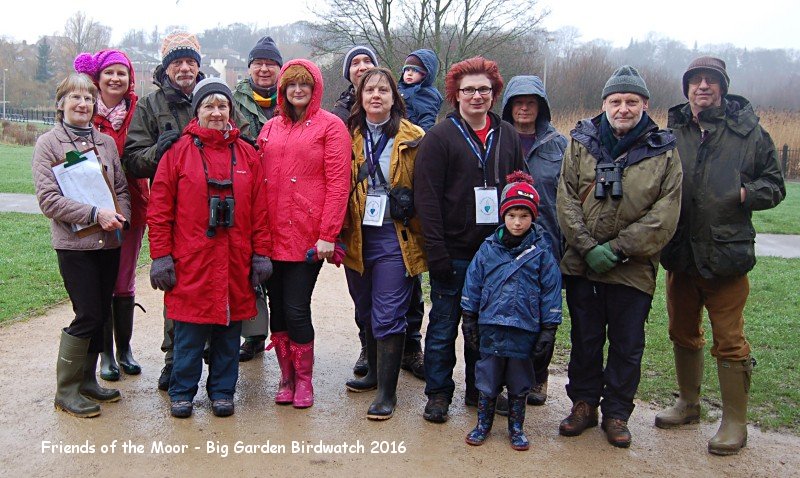| Bob's Trip to Bulgaria 2016 | The Spring Trip to Somerset | KOS Trip to Dumfries and Galloway Updated 31st December 2016.
Haydn's Pool was completely frozen over so we were surprised to see a single Snipe lurking in the reeds whilst further out a Buzzard perched close to the owl box and, in the distance, a Peregrine surveyed it's kingdom from atop one of the old ICI buildings. The facilities at the Marbury Park visitor centre have been improved but unfortunately the butty van wasn't in attendance so we had our elevenses at the viewing screen overlooking the Coward reed bed and Budworth Mere where Blue, Great and Coal Tits together with Nuthatches were using the feeding station and Water Rails were calling from the reeds below us. On the mere itself a good selection of water birds - Wigeon, Shoveler, Mallard, Moorhen, Coot, Gadwall, greylags and Canada Geese - star of the show was a very confiding Goosander swimming a few yards out from where we were stood; it was a "redhead" but areas of paler white areas on it's flanks suggested a young male bird. Neumann's Flash was almost completely iced over except for a small area of open water which was being kept temporarily clear by the presence of a concentrated mixed flock of wildfowl - Teal, Wigeon, Mallard and Shoveler plus Black-headed, Common and Herring Gulls. At this stage we had planned to drive down to Northwich town centre and the Lidl car park where Waxwings had been seen the previous day but, just in time, Sheila phoned to tell us that she and Geoff were at the Tesco store and were watching a flock there, in the same Rowan tree they'd been using a couple of years ago, we saw seven birds but Sheila reports that they counted 21 later in the afternoon. There weren't many berries on the tree this winter and even fewer on the other tree next to it so the birds will be moving on quite quickly - hopefully to Mobberley where two Cotoneasters on Town Lane, which kept a flock of up to 25 birds in food for three weeks previously, are absolutely laden with fruit! More Winter visitors have been recorded locally, Geoff and Sheila have been visited by three male Brambling and Jayne and Nick Davies counted between 20 and 25 along Beech Walk in Tatton Park on the 29th.
A Happy and Healthy new year to all KOS members and anyone else who passes this way as they drift through cyberspace. 21/12/2016...... Christmas Party 2016 and Martin Mere A busy weekend for KOS members with the annual Christmas party on Friday evening (16th) followed on Sunday with our outing to Marshside and Martin Mere. The party was a great success and our Treasurer Frank Dearden reports a healthy profit of £ 188.20,  the third highest in the society's history, 26 people attended, just one short of last year and included six who hadn't attended in previous years; it was one of these who pointed out that there aren't many places in the world where you can see a man auctioning a plate of meat pies whilst simultaneously chewing a cold sausage! the third highest in the society's history, 26 people attended, just one short of last year and included six who hadn't attended in previous years; it was one of these who pointed out that there aren't many places in the world where you can see a man auctioning a plate of meat pies whilst simultaneously chewing a cold sausage!Thanks are due to everyone who attended and those who provided the excellent selection of food especially Jude for the coronation chicken and Sue and Jacquie who prepared the delicious apple crumble that vanished so quickly. Sheila Blamire won the quiz with a 46 points out of a possible 50, I thought I'd made this years questions/id's/anagrams a little more difficult than previously, but no puzzle fooled everyone in the room, even the picture of a Masked Wagtail was correctly identified by the well-travelled Bob Groom (just wait for next years anagrams!) 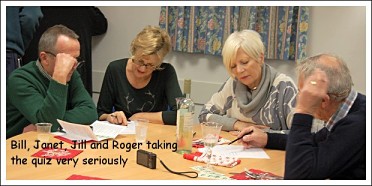 As usual our hard working Secretary Derek Pike was MC for the evening, managing to keep a semblance order and squeeze a final few bob out us during the auction - in his report, whilst considering suggestions for possible changes to the evening, Frank quite rightly points out that "people would want to retain Derek's auctioneer banter at the evening's close even if it raised not a penny"! As usual our hard working Secretary Derek Pike was MC for the evening, managing to keep a semblance order and squeeze a final few bob out us during the auction - in his report, whilst considering suggestions for possible changes to the evening, Frank quite rightly points out that "people would want to retain Derek's auctioneer banter at the evening's close even if it raised not a penny"!Sunday (18th) found us heading north on the M6 again, first up to the RSPB's Marshside reserve and later in the morning across to Martin Mere. At 7
°
C
As the relentless spread northwards of the various members of the family Ardeidae continues inland records are becoming more and more common but, apart from Rostherne which has had both Little and Great White Egrets this year, they've been few and far between around the Knutsford area. on Sunday (4th) whilst doing his regular WeBs count Bob Groom saw what was very probably the first record of Great White in Tabley Park (a bird previously well described by Ernie Hart the resident gamekeeper) ............ Lovely and bright but even the light wind was frigid. Leaves now covering the mud but also the many tree roots, real trip hazards. Finally I have seen Ernie's 'big white heron' but, frustratingly, it was only a very quick view as it flew over the mere. While there were no grey herons around for comparison, it was clearly that size. I didn't see a yellow bill but it was gone so quickly and I didn't see it again. (There was some shooting going on a short distance away and a fishing boat out.) It's tempting to say it was definitely a great white egret but there is still the outside possibility of it being an albino grey heron, though such a bird would be rarer than a GWE! Difficult... 43 Mute Swans on the mere and the regular 2 Shelducks. also 30+ Shovelers and 110 Mallards but very few other ducks. Usual female Grey Wagtail, this time in a marshy area alongside the wood. On Thursday (8th) I had an email from Carl Butterworth who, earlier in the day, had videoed a Little Egret flying over Tatton Mere before landing in the reeds in front of the Higmere plantation (you can watch it below) we believe this is a first for the park - well done Carl and many thanks! The cold spell of weather seems to have passed and, with south-westerly winds blowing up from the Azores, temperatures have risen dramatically reaching 13 ° C on Wednesday, Thursday and Friday last week. This may have prompted a Song Thrush into song this morning along Slade Lane in Mobberley although it's arctic cousins, the Redwings, weren't tempted and a flock of 59 Pinkfeet flying south reminded us that there's plenty of cold weather to come! On Sunday it's our December field trip to Marshside and Martin Mere, leaving the Tatton Street car park at 9:00am; but before then on this coming Friday (16th) it's the KOS Christmas party - one of Knutsford's most eagerly awaited social events of the year it generates much needed funds - our speakers have been excellent this year but they don't come cheap! 04/12/2016......Some good records from TattonNovember 2016 was considerably colder than the same month in 2015. My weather station shows that the average temperature (one minute intervals) was 8.4 °C in November 2015 and only 3.4 °C this year, with 14 air frosts compared to 3 last year.  Some smaller stretches of water have frozen over but the bigger meres are still clear of ice. Rostherne Mere was relatively quiet when I spent a couple of hours there on Monday afternoon (28th) with no apparent increase in wildfowl numbers. This build-up happens in really cold weather as, due to its depth, it's the last of the Cheshire meres to freeze over . Around 30 Wigeon flocked together near the sandspit, whilst further out four "redhead" Goosanders landed briefly before flying away out of site in the direction of the Whitley hide. Some smaller stretches of water have frozen over but the bigger meres are still clear of ice. Rostherne Mere was relatively quiet when I spent a couple of hours there on Monday afternoon (28th) with no apparent increase in wildfowl numbers. This build-up happens in really cold weather as, due to its depth, it's the last of the Cheshire meres to freeze over . Around 30 Wigeon flocked together near the sandspit, whilst further out four "redhead" Goosanders landed briefly before flying away out of site in the direction of the Whitley hide.On Tuesday (29th) Derek and Jean saw a female Stonechat close to Tatton Park's Melchett Mere, this bird had been seen the day before by Darren Morris and on the 24th by Alan Booth; Darren also saw another, in the deer enclosure, also on the 24th. Derek and Jean report "100s" of Canada Geese on Melchett plus a Kingfisher, whilst on the main mere they noted two male Common Scoters - an excellent record for the park. On Wednesday we travelled over to Woolston Eyes for a gentle morning birding, below the bridge at the entrance the water was mostly frozen over but a few Shovelers fed close to the shore where the ice hadn't reached. Little to see from the first elevated hide but some clear water with a selection of wildfowl could be seen in the distance so we made our way to the Morgan hide from where we'd get better views and enjoy an early sausage roll. On the walk round we passed a work party led by an enthusiastic young man on secondment from the RSPB, they were removing some of the taller trees that had been used by Magpies and Buzzards for nesting and were hoping this would encourage the Willow Tits to use the area they were clearing. I remember when we were wardening at Loch Garten big conifer trees were cut down to a height of about 5 or 6 feet leaving these remaining stumps to gently rot providing nest sites for the Crested Tits which excavate nesting cavities in rotten wood, as do Willow Tits. The feeders at the Morgan hide were very busy mainly with large numbers of Greenfinches plus Goldfinches, Blue, Great and Willow Tits and a phylloscopus warbler, presumably a Chiffchaff. The wintering Bramblings, so noticeable last Winter, have yet to re-appear. Moorhens and Coots seemed quite at home on the ice in front of the hide whilst further away where some clear water remained a selection of wildfowl were concentrated into a small area - Mallards, Shoveler and lots of Teal including a difficult to find Green-winged Teal - an escaped bird if you have one on your various lists, an obvious wild bird if you haven't!
Rather a long piece so I've put it on a separate page - click here While we were away there were some very big tides and Bob and Jacquie drove down to Parkgate to see if they could pick up any of the specialities - here's his email Our weather continues to arrive from the east and it's much colder than this time last year, on Tuesday morning (8th) at 6am my weather station recorded -3.2 °C. Last Wednesday (2nd) at 7:30am a high flying flock of c.150 Pinkfeet passed over Mobberley heading east, there are few more exciting sounds for we birders - wild, evocative and timeless - perhaps they were anticipating the cold snap to come. Later in the morning we drove over to Warrington 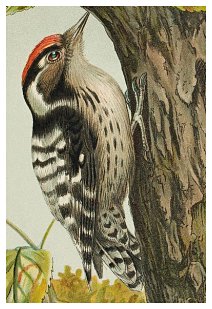 and the Woolston Eyes reserve; we had hoped to see the immature Hen Harrier that had been seen earlier in the week quartering the reed beds, this bird has been fitted with a satellite tracker enabling realtime monitoring of it's position. This data won't be made public immediately in case it's used by members of the shooting fraternity to establish it's location, a pity - but a sign of the times. In contrast you can follow the movements of Spoon-billed Sandpipers in Myanmar using the same technology! and the Woolston Eyes reserve; we had hoped to see the immature Hen Harrier that had been seen earlier in the week quartering the reed beds, this bird has been fitted with a satellite tracker enabling realtime monitoring of it's position. This data won't be made public immediately in case it's used by members of the shooting fraternity to establish it's location, a pity - but a sign of the times. In contrast you can follow the movements of Spoon-billed Sandpipers in Myanmar using the same technology!We didn't catch up with the Harrier, but managed a total of 40 species during the morning, nothing unexpected but good views of things like Sparrowhawk and a nice Grey Wagtail in front of the Morgan hide where Bob had two Goosanders just before we left. The Lesser Spotted Woodpecker has been seen and/or heard a couple of times at Rostherne, it was watched just below the observatory and identified as a male bird. No sign of it yesterday afternoon (8th) but there was plenty of activity, mainly thrushes - Redwings and Mistle Thrushes especially, no large numbers of Fieldfares yet but I did find a solitary Song Thrush amongst the Redwings. Also on the Reserve five Mandarins including two fine looking males at the outlet of Rostherne Brook, 23 Shovelers feeding in front of the boathouse and just before leaving a Little Egret flew down the length of the mere before heading off towards Tatton Park.
We enjoyed a pleasant morning last Wednesday (26th) at Burton Mere, quite misty at first with the power plants across the Dee estuary belching out clouds of steam, looking very photogenic in shades of grey and white; eventually though the sun burnt off the murk and the temperature rose to 17 °C leaving perfect conditions for a spot 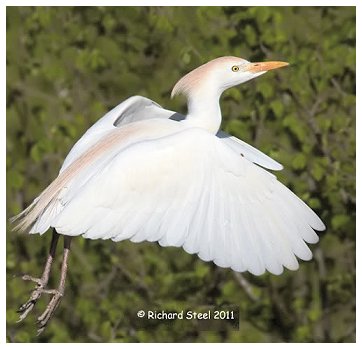 of birding. of birding.Following in the footsteps of those other southern European species - Little Egret, Great White Egret and Spoonbill - Cattle Egrets seem to be expanding their range and five birds recently arrived on the Reserve. We had hoped to see these and we weren't to be disappointed as they were on view from the reception building, clearly at home following the cattle through the reed beds and at one stage one of the birds perched on the back of one of the cows - just like you see in the books! We managed an excellent total of 60 species during the morning - large flocks of Pinkfeet were on the move with several groups of 100+ birds arriving from the estuary, on the wader scrape in front of the Inner Marsh hide Sheila managed to pick out 5 Dunlin and 2 Ruff amongst the numerous Redshanks. Back at the reception building three Marsh Harriers looked great as they floated over the water meadows as we enjoyed a cup of RSPB coffee before heading for home (incidentally an enterprising chap has set up a Butty Van in the car park (with the agreement of the RSPB)so visitors can enjoy a freshly made bacon bap rather than the crisps and biscuits normally on offer)
Another encouraging turnout on Friday evening when 30 members and visitors enjoyed an excellent talk by Paul Hobson who recounted his journeys through Namibia, South Africa, Rwanda and Kenya; this wasn't just a "bird on a stick" lecture but an entertaining travel log covering subjects such as the Rwandan War and how to stay clear of the Lords Army! On the subject of exotic locations I learn that some members will be heading for the sun over the next few days including trips to Peru, California and even Hawaii - Aloha!
The easterly winds have returned after a short interval of westerlies last week and they've brought with them more Winter visitors. In Mobberley on Thursday (20th) there was another noticeable increase in the number of Redwings, 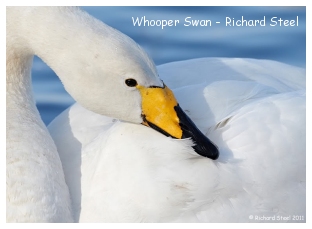 Blackbirds and Mistle Thrushes plus the first flock of Fieldfares, a group of about 20, flying south over Hobcroft Lane. Dave Higginson from Greenbank Farm along the lane tells me they've been struck by an outbreak of bovine tuberculosis and so far he's lost 25 milking cows and 10 in-calf heifers, they are the only dairy farm left in the immediate area and don't "buy-in" any animals. He suspects it's been spread by Badgers. Geoff and Sheila Blamire report their first garden Redwing arrived on the 16th, followed by a very early Brambling just two days later. Blackbirds and Mistle Thrushes plus the first flock of Fieldfares, a group of about 20, flying south over Hobcroft Lane. Dave Higginson from Greenbank Farm along the lane tells me they've been struck by an outbreak of bovine tuberculosis and so far he's lost 25 milking cows and 10 in-calf heifers, they are the only dairy farm left in the immediate area and don't "buy-in" any animals. He suspects it's been spread by Badgers. Geoff and Sheila Blamire report their first garden Redwing arrived on the 16th, followed by a very early Brambling just two days later. On Thursday afternoon (20th) Derek and Jean were walking in Tatton Park when they were surprised to come across a small flock of 12 Whooper Swans, 8 adults and 4 juveniles on Melchett Mere, a great record! Interestingly a flock of 12 spent a few hours on Rostherne Mere on October 28th last year, there's a good picture of them in the 2015 Rostherne Report taken by Steve Collins. The report is an excellent publication, well written with some great pictures by Steve and plenty of graphs and charts that reveal some interesting population trends using data that can go back over one hundred years! The report is free for members. I spent a couple of hours there on Friday afternoon (22nd), a nice male Goosander was going to be the highlight until, as I was making my way out, a Lesser Spotted Woodpecker called loudly from the top of a Lime tree in the churchyard before flying directly 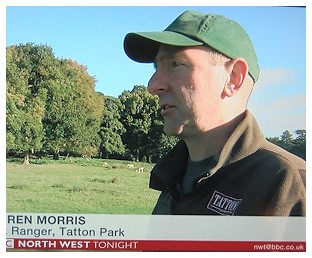 overhead into a Willow tree on the edge of the cricket pitch, I wasn't able to re-locate it. overhead into a Willow tree on the edge of the cricket pitch, I wasn't able to re-locate it.Bob and Jacquie have been across to the Wirral again and seem to have enjoyed some success ........... It was a seven bird-of-prey day today at the Parkgate High Tide event. We missed Merlin (one was seen very briefly) but had good views of fem. Marsh Harrier, Short-eared Owl, Peregrine (3 birds circling together), Buzzard, Kestrel and Sparrowhawk! 30 Pink-Feet flew over and there were all the usual waders (including lots of Curlews), Little Egrets etc..Early on at Leasowe we had showers but for the rest of the day the sun shone. We called in at Burton but missed cattle egret again. More views of Marsh Harrier etc....... I believe there are now 5 Cattle Egrets at Burton Wetlands. On Saturday Martin Hughes-Games tweeted that he'd been sacked by the BBC "The BBC commissioner Tom McDonald has decided my services no longer required on Springwatch etc. Sad, but it's been brilliant. Thank you." There followed a rush of angry tweets from his followers prompting a statement from the Corporation which explained that he hadn't been dropped from Springwatch and insisted talks were continuing over what a spokesperson described as his "evolving" role. Whatever the outcome I think the BBC could do worse than giving the job to Tatton Ranger and KOS member Darren Morris, who again appeared on BBC TV during the week when they visited Tatton for a piece about rutting deer, he seems to be their go-to man on this sort of subject! Don't forget, we have a meeting this Friday (28th) when Paul Hobson will be talking to us about "African Delights" 17/10/2016...... KOS field trip to Connah's Quay
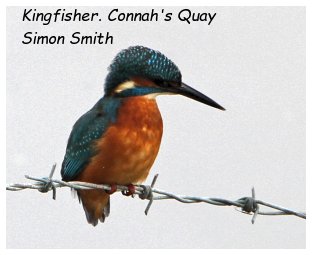 Security is taken very seriously and our KOS field trip on Saturday (15th) began at a locked barrier where we were greeted by Phil Hotchkiss the Chairman of the DNS who escorted us down to the Field Studies Centre where we met up with other members and were given an introduction to the Society, it's work and the Reserve. Security is taken very seriously and our KOS field trip on Saturday (15th) began at a locked barrier where we were greeted by Phil Hotchkiss the Chairman of the DNS who escorted us down to the Field Studies Centre where we met up with other members and were given an introduction to the Society, it's work and the Reserve.The first bird on the day's list proved to be a Kingfisher, perched on a branch overhanging a pool outside the Centre, we saw it a number of times during the course of the day. As the high tide was at 11:15am Phil suggested that it would be best if we drove down to the West hide first and then visit the other hides later in the day, this we did and enjoyed great views from this impressive two storey tower that afforded uninterrupted views over the ash pool, the wetland meadows and right across the Dee estuary towards Burton and Parkgate, these two locations were initially hidden from view as it was still very misty, although the rain that greeted our arrival ceased shortly after the Hon. Secretary had donned his waterproof over-trousers - we must remember that trick Derek! 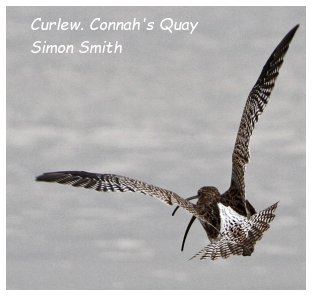 The Kingfisher had followed us up to this end of the reserve and again showed well on the ash pool along with Coot, Moorhen, Shoveler and a nice Grey Wagtail; Reed Buntings, Meadow Pipits and Linnets were much in evidence as they commuted between the shrubbery surrounding the pool and a barbed wire fence on which the Kingfisher eventually alighted, just below the hide. The Kingfisher had followed us up to this end of the reserve and again showed well on the ash pool along with Coot, Moorhen, Shoveler and a nice Grey Wagtail; Reed Buntings, Meadow Pipits and Linnets were much in evidence as they commuted between the shrubbery surrounding the pool and a barbed wire fence on which the Kingfisher eventually alighted, just below the hide.Two Great Crested Grebes and a few Cormorants fed out on the river whilst much further away Parkgate was now in view as the mist lifted and over the reedbeds we saw an unidentified Harrier and a probable Great White Egret, Little Egrets were plentiful but it was only recently that the first Great White was recorded actually on the Reserve. As high tide was reached the sun came out and in the distance flocks of Black-tailed Godwits put on a wonderful display, flashing grey and dazzling white as they twisted and wheeled over the estuary, there was no apparent reason for this behaviour as the tide was now beginning to recede, but perhaps the Peregrine perched high up on one of the pylons was making them a bit skittish! On our last visit to Connah's Quay one of the highlights was the flock of Twite feeding in the car park, unfortunately this time we were a few weeks too early, apparently the birds were still feeding on aphids and wouldn't return until they'd exhausted this food source. There's an excellent article on the species here. As the tide went out we made our way back to the Centre and enjoyed lunch in warmth and comfort (the Reserve is jointly managed by E.ON. and the DNS, apparently E.ON. pay the electric bills and as Phil is an electrician all the radiators work!.) Part two of the visit saw us spending some time exploring the three hides closest to the Centre, we added a few new species including Little Grebe, Goldcrest and 13 Greenshanks but by now the tide was receding quickly and there was little activity on this particular stretch of the Reserve. Our thanks go to Phil and his colleagues for their friendly welcome and allowing us access to this wonderful stretch of the Welsh coast. The story of the Siberian Accentor on the Shetlands proved to be popular and things took an amusing twist last weekend. Apparently a group of twitchers chartered an aircraft to fly them up to Lerwick on the Monday (10th) at a cost rumoured to be £ 800 per person, what they didn't know was that there'd been an unprecedented influx and by Thursday two more had appeared, at Hendon in County Durham and Easington Yorkshire!! Have look at what the newspapers made of it no wonder people think birders are a bit weird - hundreds of old blokes who must surely all be fully paid-up members of the DMC! NB
The recent run of easterly wind, much appreciated by residents of Mere, has produced some remarkable records from favoured hot spots, especially the Shetland Islands where species such as 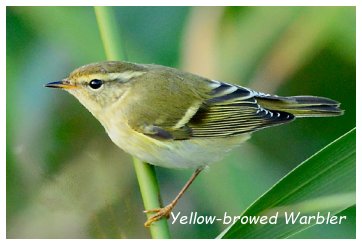 Black-faced Bunting, White's Thrush, Siberian Thrush and Brown Shrike have appeared, cumulating this week with Britain's first Siberian Accentor! Yellow-browed Warblers are widespread, even here in the west of the country, and three have been ringed in the past week at Woolston Eyes, other records have come from all over the north-west. Closer to home, in Mobberley, there's been a noticeable increase in Blackbirds over the past few days and this morning (13th) three small separate groups of Mistle Thrushes, only totalling 10 birds, passed overhead flying in a south-westerly direction. Black-faced Bunting, White's Thrush, Siberian Thrush and Brown Shrike have appeared, cumulating this week with Britain's first Siberian Accentor! Yellow-browed Warblers are widespread, even here in the west of the country, and three have been ringed in the past week at Woolston Eyes, other records have come from all over the north-west. Closer to home, in Mobberley, there's been a noticeable increase in Blackbirds over the past few days and this morning (13th) three small separate groups of Mistle Thrushes, only totalling 10 birds, passed overhead flying in a south-westerly direction.Yesterday (12th) we enjoyed a gentle stroll around Tatton Park (6km according to my new phone app) starting on Knutsford Moor (the Moor), as usual this was the most productive part of the morning; there was no sign of Cetti's Warbler, but we remain cautiously optimistic for next Spring, plenty of small birds were feeding in the tangle of undergrowth and shrubbery - Great Tits, Blue Tits and Coal Tits, at one stage I thought I heard a Willow Tit call briefly but time and the rest of the troops were moving on so that will have to wait until more time is available. The back Moor pool was quite busy with Coot, Moorhen, Mallard, Tufted Duck, Great Crested Grebe and Gadwall all on show, we also had a quick glimpse of a Kingfisher and a Water Rail was calling discordantly from the phragmites. Tatton main mere also had good numbers of wildfowl and we were able to add Shoveler, Pochard and a newly returned female Goldeneye to the list; we didn't do a count but earlier in the week Alan Booth had 110 Tufted Ducks, 20 Pochard and 10 Shoveler. Elevenses we taken in the Allen hide, Melchett Mere and the feeders were very quiet, just a group of 6 Egyptian Geese loafing on the waters edge giving us time to put the world to rights: the Hon. Treasurer and the Hon. Chairman enjoyed an in depth discussion about the latest offering from the RSC at Stratford-on-Avon (I did google it but it appears that the RSC Website as been hacked!) whilst the rest of us were more concerned with the continuing problems of the England football team. Sheila has lent me a copy of "The Heron" the magazine of the RSPB Macclesfield Local Group, they enjoyed a visit to Speyside earlier this year staying at the Grant Arms in Grantown-on-Spey, this is where we'll be based on our trip next June and the report makes interesting reading; they had 112 species during the time they were there so I think we should make this our target for this much anticipated return to the highlands.
A friend of mine is a keen amateur astronomer, a pastime that, in his case, entails sitting out in the garden after sunset observing the night sky. 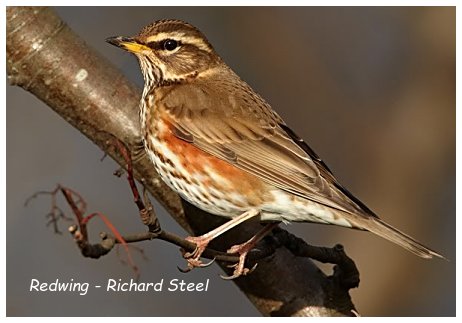 Like many of us he's now past his sell-by-date but his hearing is still very good and he phoned me on Sunday(2nd) to report detecting the thin calls of migrating Redwings passing overhead, these were the first of the Autumn and I heard a steady stream as I ventured outside shortly after he'd contacted me. Over in Crosby Barrie Armitt had two Redwings on Sunday, followed by a count of 253 the following day, he also had 11,421 Pink-footed Geese leaving their overnight roost as a red dawn broke over the Liverpool Bay area. A few Redwings flew west over the fields of Mobberley this morning (6th) plus many Meadow Pipits and a steady trickle of Skylarks - Autumn is definitely here. Like many of us he's now past his sell-by-date but his hearing is still very good and he phoned me on Sunday(2nd) to report detecting the thin calls of migrating Redwings passing overhead, these were the first of the Autumn and I heard a steady stream as I ventured outside shortly after he'd contacted me. Over in Crosby Barrie Armitt had two Redwings on Sunday, followed by a count of 253 the following day, he also had 11,421 Pink-footed Geese leaving their overnight roost as a red dawn broke over the Liverpool Bay area. A few Redwings flew west over the fields of Mobberley this morning (6th) plus many Meadow Pipits and a steady trickle of Skylarks - Autumn is definitely here.Across the other side of the Mersey Estuary from Crosby at Hoylake and again on the 2nd, Bob Groom and Jacquie Ledward recorded 240 Curlews at high tide as well as 1,000 plus Oystercatchers, 3 Grey Plovers, Bar & Black-Tailed Godwits and the usual small waders plus Common Scoter, 3 Sandwich Terns and a Peregrine falcon. The weather by then was atrocious with heavy rain so they made their way to Burton Mere RSPB Reserve and it's sheltered hides where they enjoyed super 'scope view of a Curlew Sandpiper, but missed out on the Cattle Egret that has been around on the reserve for some time. On Wednesday (5th) we paid a long overdue visit to Northwich hoping to hook up with the Spotted Crake that had been on Neumann's Flash for the past week or so. We didn't see it but there was a surprisingly good selection of waterfowl including 15 Little Grebes, Mallard, Gadwall, Tufted Duck, Pintail, Shoveler, Wigeon and even a female Scaup. Waders were well represented too, we had Snipe, Lapwing, Ruff, Dunlin, Golden Plover and a nice flock of Curlew.
Last year I wrote about the spread of Cetti's Warblers and how, for many years, we'd been anticipating their breeding on Knutsford Moor. Well I think we're almost there! Yesterday (28th) 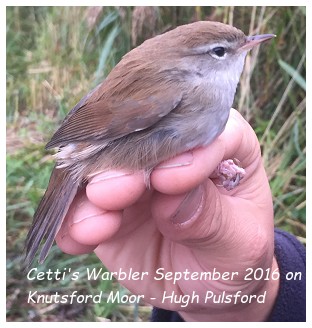 KOS member and County Recorder Hugh Pulsford caught a female Cetti's on the Moor during ringing operations, interestingly it was already ringed so this should provide some valuable information when Hugh receives details of where and when this initial ringing took place. Hugh also mentioned ringing no less than 40 Grey Wagtails during September and when he returns from a birding expedition to the South West at the end of October he'll provide us with an account of ringing activities on Knutsford Moor this year. KOS member and County Recorder Hugh Pulsford caught a female Cetti's on the Moor during ringing operations, interestingly it was already ringed so this should provide some valuable information when Hugh receives details of where and when this initial ringing took place. Hugh also mentioned ringing no less than 40 Grey Wagtails during September and when he returns from a birding expedition to the South West at the end of October he'll provide us with an account of ringing activities on Knutsford Moor this year.Last Friday (23rd) Bob Groom was in Tatton Park and was pleased to come across a passing Wheatear perching on thistle stalks in the open area near the Millennium Wood plus a large flock of 55 Meadow Pipits at the same spot. Over the mere 3 Swallows and 4 House Martins, I had a single Swallow over Mobberley yesterday afternoon heading steadily south, we'll not see many more but the Martins may be around for a few more weeks - even into November. A good gate on Friday (23rd) as a crowd of 32 clicked through the turnstiles at the Jubilee Hall for our first indoor meeting of the season; the Hon.Treasurer left with a smile on his face having taken
£
154 in entrance fees and memberships, including contributions from 3 new Members - welcome to Bernard McLenaghan, David Eyes and (at last) all the way from the Britannia Stadium Darren Morris! The current spell of unseasonably warm weather seems to coming to an end with weather systems queuing up in the Atlantic 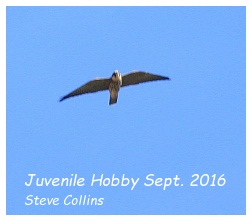 ready to remind us that we're just a couple of days away from the autumnal equinox. Last Tuesday (13th) was the hottest day of the year with 34.4°C recorded in Gravesend, up here though it was a much more manageable 24°C and the day ended with heavy rain and a spectacular lightning show. The following day (14th) I joined Bob Groom at the local Hobby site and for two hours we enjoyed memorable views of the two juvenile birds as they fed on a ready supply of flying insects, building up their reserves before migrating south for the first time (probably within the next ten days). The "record shot" was taken by Steve Collins ready to remind us that we're just a couple of days away from the autumnal equinox. Last Tuesday (13th) was the hottest day of the year with 34.4°C recorded in Gravesend, up here though it was a much more manageable 24°C and the day ended with heavy rain and a spectacular lightning show. The following day (14th) I joined Bob Groom at the local Hobby site and for two hours we enjoyed memorable views of the two juvenile birds as they fed on a ready supply of flying insects, building up their reserves before migrating south for the first time (probably within the next ten days). The "record shot" was taken by Steve Collins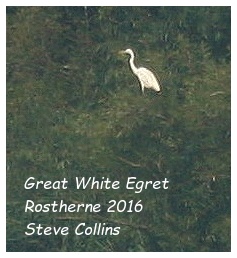 on Saturday (17th), Steve also provided me with the image of Rostherne's Great White Egret that was first seen last Wednesday (14th), as far as I know it's still there and spends most of it's time in the reed bed in front of Mere Covert, across the far side of the reserve from the obs. on Saturday (17th), Steve also provided me with the image of Rostherne's Great White Egret that was first seen last Wednesday (14th), as far as I know it's still there and spends most of it's time in the reed bed in front of Mere Covert, across the far side of the reserve from the obs.It was another fine day on Sunday for our trip across the sands of Dee to Hilbre Island, unfortunately circumstances dictated that most of the regulars were unable to make the journey so it was a party of only four stalwarts that followed the tide out to the island, not the smallest ever turnout (I remember three of us once enjoying a trip to the Point of Air some years ago) but nevertheless quite disappointing. Assuming a normal distribution one day no one will appear (I'll let Mark or Geoff calculate the odds!).
Summer made a very welcome and timely re-appearance this week with temperatures up into the mid-twenties, just in time for the Tour of Britain cycle race as it passed through Knutsford and Mobberley on Tuesday (6th) and for our mid-week trip over to Burton Wetlands Centre the following day. The race took part solely in Cheshire, passing through Tatton at about 1pm before heading through Ashley and Mobberley and then away into the Pennines before returning to finish in the park. The event attracted large crowds into the village and the route included Smith Lane and Town Lane, part of the Mobberley 5K so residents were well used to seeing athletes passing through! The reception Building at Burton was in Etihad mode, Natural England have done a good job at Rostherne removing the fallen tree blocking the path to the obs. and I was able to spend a pleasant couple of hours there on Thursday (8th). I met Steve Collins there and later Alan Booth arrived, we had Green Sandpiper, Common Sandpiper and a Little Egret, all on the sand spit where Rostherne Brook empties into the mere.
Sheila Blamire's excellent picture of the Little Tern taken at Gronant Point during our short visit there in July has yielded some interesting information. As you can perhaps make out the bird has a colour ring on it's left leg, not very distinct on this reduced image but on the original Sheila could read quite clearly the letters XAC. 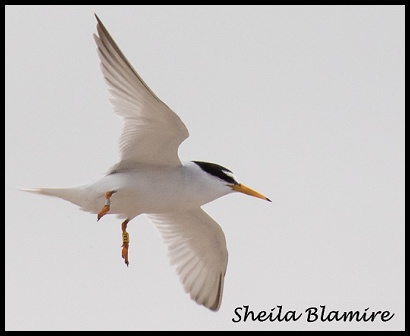 She has received the following information from David Norman who is studying the species at Gronant............... She has received the following information from David Norman who is studying the species at Gronant............... "XAC was originally ringed as a chick at Gronant on 5 July 2009 then trapped on the nest on 25 June 2015 as a breeding male. This is a decent age but Little Terns are quite long-lived with the British record-holder still alive at almost 22 years old (https://app.bto.org/ring/countyrec/results2015/longevity.htm) and I have had dead ringed birds in the Gronant colony at 8, 9, 11 and 19 years of age. I started colour-ringing last year as part of the EU LIFE+ project (http://www.rspb.org.uk/whatwedo/projects/details.aspx?id=362308), a 5-year, multi(11)-partner project to try to understand more about the species and to try to increase its UK population. We have also started trapping adults on the nest at the late stage of their incubation using walk-in traps, but just did two in 2015 and two in 2016. For decent visibility the colour-rings have to be taller than the metal rings so they are suitable only for adults and the larger chicks: I colour-ringed 20 chicks and two adults in 2015, and 34 chicks and two adults in 2016. One of the main points of it is to look for colour-rings in future years, for recording site-fidelity or colony interchange, and age of first breeding which is still not well known (probably 3 but possibly 2 in some individuals). XAC had actually been seen in June this year by one of the site wardens but it was very encouraging that you were able to see it and take such a clear photograph............" It looks like I've incurred the wrath of the spirits at Rostherne with my comments about Slow Birding and the Dull Men's Club as, after Bob Groom's rare Flycatcher on I was planning to recommend Rostherne Mere as an ideal venue for members of "The Dull Men's Club" but that idea has been put on hold with the exciting news that on Friday morning (26th) Bob Groom discovered what will be the 219th species on the all-time Rostherne Mere bird list (if it is accepted) 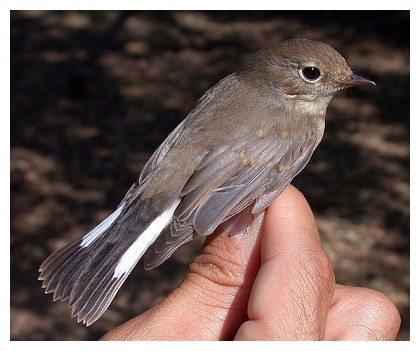 . Bob was watching a mixed flock of Warblers and Tits feeding in the undergrowth in front of the observatory close to the waters edge, when his attention was drawn to a small bird markedly different from any of it's companions and he immediately identified it as a Red-breasted Flycatcher. In his notes in the logbook Bob mentions the birds small size, it's noticeable eye ring and especially the bright white area at the base of the tail. This is not a difficult species to identify, we've seen them on Lindisfarne on a number of occasions and Bob has also seen them on the continent and even in Morocco so I don't think there will be any problem getting this fine record accepted by the Cheshire rarities committee. . Bob was watching a mixed flock of Warblers and Tits feeding in the undergrowth in front of the observatory close to the waters edge, when his attention was drawn to a small bird markedly different from any of it's companions and he immediately identified it as a Red-breasted Flycatcher. In his notes in the logbook Bob mentions the birds small size, it's noticeable eye ring and especially the bright white area at the base of the tail. This is not a difficult species to identify, we've seen them on Lindisfarne on a number of occasions and Bob has also seen them on the continent and even in Morocco so I don't think there will be any problem getting this fine record accepted by the Cheshire rarities committee.Bob returned in the evening and I joined him there to see if we could re-locate the bird; we were unsuccessful but we enjoyed a few quiet hours birding ending with a spectacular sunset (below) Wednesday (24th) found us once again at the Woolston Eyes Reserve; things were a bit quiet - relatively speaking of course, some of the species we see on a regular basis there would cause palpitations at Rostherne! A Goosander had been seen from the bridge earlier in the day but there was no sign of it when we arrived, although a Kingfisher there gave good prolonged views just below us as we crossed over onto number 3 bed. Black-tailed Godwit and Lapwing numbers are increasing nicely, amongst a large group of the latter Derek located a Greenshank that seemed quite settled and showed well when all the waders took flight as a passing Sparrowhawk spooked them. I know some people who read this section of the website live abroad so they may be interested to know that the Tour of Britain cycle race passes through our area on Tuesday 6th September and will be shown live on satellite TV all around the world click here. The race passes through Knutsford twice during the day ending in Tatton Park; you'll even be able to watch as the riders pass through Mobberley - along Smith Lane and Town Lane - right past the end of our avenue!!
In their book "The Birds of Cheshire" from 1900 Coward and Oldham tell us ...... in Cheshire the Goldfinch as a resident is rapidly becoming rarer, and has been exterminated in most districts. 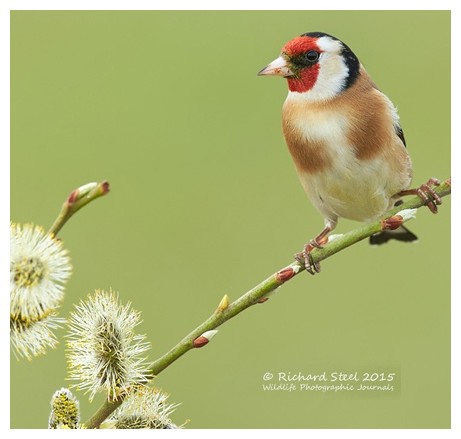 The reclamation of waste has curtailed its haunts and persistent persecution by bird-catchers has been instrumental in further reducing its numbers. Immigrants are occasionally seen in Winter in districts where the bird is extinct as a breeding species...... The reclamation of waste has curtailed its haunts and persistent persecution by bird-catchers has been instrumental in further reducing its numbers. Immigrants are occasionally seen in Winter in districts where the bird is extinct as a breeding species......How things have changed, it's now probably the most numerous of the finches to be found in the county. This week they've returned to our garden in force - adults and juveniles, emptying the feeder at a great rate of knots! We don't use nyger seeds, they are quite happy with sunflower hearts as are the other species that visit us, currently Blue and Great Tits, Greenfinches, House Sparrows, Nuthatches and the Coal Tits all taking the food directly whilst Blackbirds, Chaffinches and Dunnocks hoover up the surplus dropping to the floor. Bob Groom's Hobbies are progressing nicely, last Tuesday (16th) the nest contained two well-grown young, so it won't be long before they fledge, perhaps they'll be seen at the Swallow roost along Green Lane where Bob had two Hobbies last Sunday(14th). Ken and Shirley Davies have returned home after their Scandinavian adventure, but not for long, Ken tells me on Saturday they'll be taking the ferry to Dunkirk before moving onward to Bavaria and perhaps Italy! Ken has sent me a brief resume of their route in Scandinavia and a list of the species seen.At last chance to send you the list of birds, in roughly the order we found them as we travelled from home to Harwich, to the Hook of Holland, through Holland, Germany, Denmark. Ferry to Bergen, up the west coast of Norway, right up to the North Cape and back via Finland. Down the east coast of Sweden, over to the island of Gotland, back to mainland Sweden, onto the island of Oland, down to southern Sweden, ferry to Germany and back via Northern Holland and home 6,405 miles not counting the many ferries we went on.
It's always a bit strange, given the time of the year, to hear so much bird song coming from the reedbeds at Woolston Eyes, but it was there on Wednesday (10th)- Reed and Sedge Warblers, Common and Lesser Whitethroats and even Cetti's Warbler could all be heard in short snatches as we climbed up the steps to the first elevated hide. There's a simple explanation though - it's a looped recording being played (quite loudly) by members 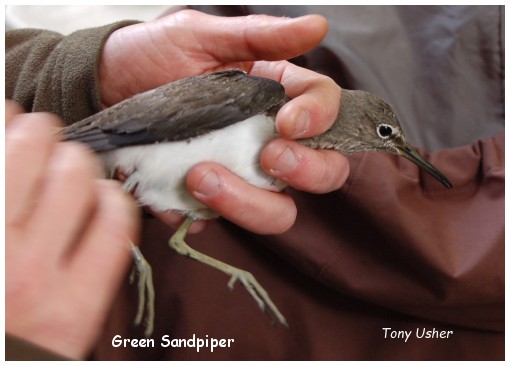 of the Merseyside Ringing Group to lure birds down to the area where their mist nets have been set up deep in the reeds. As well as the normal passerines that can be expected in August, over the past few days they have caught and ringed five Green Sandpipers, in addition to the normal metal BTO ring these individuals have had of the Merseyside Ringing Group to lure birds down to the area where their mist nets have been set up deep in the reeds. As well as the normal passerines that can be expected in August, over the past few days they have caught and ringed five Green Sandpipers, in addition to the normal metal BTO ring these individuals have had The water level on number 3 bed has been lowered to attract waders and it appears to be working, as well as the Green Sandpipers the bed held eight Snipe, two Dunlin, three Common Sandpipers, 13 Black-tailed Godwits, 65 Lapwings and I believe that the first Greenshank of the season was seen yesterday (11th). All three species of hirundines were moving through, a single Sand Martin, a handful of Swallows together with large numbers of House Martins skimmed low over the water, whilst higher up just one Swift heading rapidly south, perhaps the last one we'll see before April next year. Most of the Black-necked Grebes have left the reserve, just three well-grown young birds remained and I presume they'll be on their way before too long; the feeders, brimful with sunflower seeds, were attracting very large numbers of Greenfinches, they must have done well this Spring, lets hope they steer clear of the Trichomonosis that has been responsible for a rapid decline in numbers over the past few years. In complete contrast to the busy comings and goings at Woolston, on returning from Rostherne two weeks ago I dug out my copy of "The Birds of Rostherne Mere" [1976] by Ron Harrison and David Rogers. It reminded me what a special place it was for us at that time before the WWW and mobile phones. So, just for old times sake, I paid a visit later the next week and quite enjoyed it! If anyone hasn't a copy of the book you're welcome to borrow it.
 We split into two groups, I went with Phil who led those with wellies on a complete circuit of the mere whilst Steve guided the remainder on a shorter route taking in the observatory plus the Whitley hide and surrounding reed beds. We split into two groups, I went with Phil who led those with wellies on a complete circuit of the mere whilst Steve guided the remainder on a shorter route taking in the observatory plus the Whitley hide and surrounding reed beds.We walked down the steep slope to the waters edge following in the footsteps of generations of Cheshire bird watchers - Coward, Boyd, Hedley Bell, Samuels and our own Bill Mulligan their ageing black and white portraits still adorn the walls of the observatory. A reminder to us current birders of our own mortality! We always knew that this was never going to be the best time of the year to visit Rostherne for birds, and indeed this was the case. Nesting is now complete so there was very little in the way of song and the wildfowl were in eclipse plumage, the Canada Geese and Greylags are currently completely flightless whilst their flight feathers are replaced. There was though some colour and activity, an Oystercatcher dropped in along the lakeside and a Kingfisher powered along low over the mere; a bright flash of opal blue. Phil had warned us it would be a bit muddy in places and it certainly was in Harpers Bank Wood, this is where the Cormorants nest and this year there were no less than 160 pairs - have you any fishing friends? Best not tell them about this! The woodland of Mere Covert was quiet, except for a singing Stock Dove and short bursts from a Chiffchaff and a Reed Warbler as we made our way around the reed beds at the eastern end of the mere before meeting up with Steve's group back in the observatory. Despite covering less ground they'd had quite an exciting time with sightings of a Raven, a Hobby hunting dragonflies and, best of all, a Cuckoo! The BTO is doing a lot of work with Cuckoos, they're fitting tiny satellite transmitters to the birds which allow their movements to be followed over a period of years [click here] amongst many other things it's been shown that most adult Cuckoos have left Britain by the end of June and begun their migration back to Africa leaving their offsprings to fend for themselves before following them weeks later. So Friday's bird was probably a juvenile bird and three quickly taken "grab shots" by Steve seem to confirm this; perhaps it was brought up by a pair of Rostherne's numerous Reed Warblers. 42 species was not a bad total given the time of year and our thanks go to Phil and Steve for their time and effort which made for such an enjoyable evening. On his way home Steve stopped off in Pavement Lane and reports seeing two of the Barn Owls and as a bonus the pair of Little Owls that are also resident in the area, often heard but rarely seen. In Tatton Park, whilst walking Patch, Tony Ellis came across a singing Grasshopper Warbler in the plantation just to the west of the Old Hall, probably the only record for the park this year.
Following the welcome news that Spotted Flycatchers had bred in Tatton Park Alan Booth contacted me with another sighting, this time two birds seen on Gleavehouse Lane in Mobberley. I saw them there a few days ago, I'm assuming they've nested somewhere in the vicinity. Further down the lane where it joins Pavement Lane I met up with KOS members Bob Groom and Sue and Jim Middleton who were watching for the Barn Owls, eventually and just as the last bit of daylight was lost we saw no less than four birds in the vicinity of the nest box. 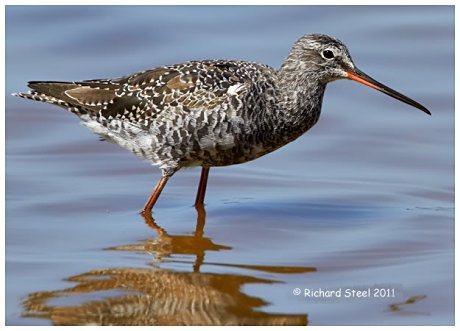 Yesterday (27th) we paid a visit to the RSPB's Burton Wetlands Reserve on the Wirral via the Gordale Garden Centre where the National Exhibition of Wildlife Art was again being held. There were some beautiful items there but inevitably stuff like that comes at a price, nevertheless last year 45% of the exhibits found a new home and I believe one of our number will be returning over the weekend with their chequebook! I made do with a coffee in the restaurant and I must say it was excellent. Yesterday (27th) we paid a visit to the RSPB's Burton Wetlands Reserve on the Wirral via the Gordale Garden Centre where the National Exhibition of Wildlife Art was again being held. There were some beautiful items there but inevitably stuff like that comes at a price, nevertheless last year 45% of the exhibits found a new home and I believe one of our number will be returning over the weekend with their chequebook! I made do with a coffee in the restaurant and I must say it was excellent.A pair of Spotted Crakes have bred at Burton and the reception building was much more crowded than usual as people waited patiently for the appearance of one of the adults or the single youngster that seems to have survived. In due course there was a rush to the 'scopes as a small dark coloured bird appeared in amongst the vegetation across the far side of the lake and was considered by those that know about these things to be a juvenile Spotted Crake. I did manage a few seconds on Sheila's 'scope but had only poor views as it slipped into the reeds, earlier in the morning a juvenile Water Rail had also been seen at the same spot - so you pays your money and takes your choice! Don't forget tomorrow evening (Friday 29th) Phil Dell and Steve Collins will be giving us a tour of the Rostherne Reserve, meeting in the Natural England car park opposite Egerton Hall at 6.30pm. We'll be splitting into two groups - group one will confine their activities to the Whitley hide and the Observatory: anyone
Friday's evening walk around the Rostherne Mere Reserve has been postponed and re-scheduled for the following Friday (29th) as the original date clashes with the RHS Flower Show in Tatton, the event always causes traffic chaos in the local area and beyond. Mike Duckham, originally from Timperley and now living in Llandudno, 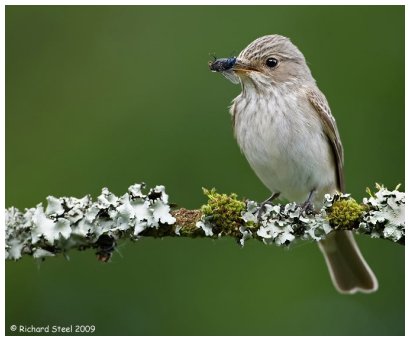 visited the park on Monday and found two families of Spotted Flycatchers one behind the Rostherne Lodge and a second in the copse of Sweet Chestnuts on the left along the walk to the house. visited the park on Monday and found two families of Spotted Flycatchers one behind the Rostherne Lodge and a second in the copse of Sweet Chestnuts on the left along the walk to the house.Bob Groom counted a flock of 110+ Swifts over Tabley Hill on Saturday (16th), in our part of Mobberley I think we've only one pair this year but they seem to have been successful, the family are very active in the evening - two adults and three young judging by their behaviour. The same noisy scene just down the road in Shaw Heath but on a larger scale, at the weekend I counted at least 50 birds overhead, many family parties, screaming youngsters in pursuit of their parents creating most of the noise. On Sunday (17th) Bob was birding in Mobberley and had extended views of two Hobbies that eventually made off in the direction of Spring Wood, they've nested there in the past but this is the first record of birds in that area this Summer. I spent a couple of hours there last night with no luck although I had good views of a Barn Owl hunting over a newly mown meadow, presumably one of the birds from Pavement Lane. I received my copy of the 2015 Woolston Eyes Conservation Group Annual Report this week, it's an excellent publication and it's well worth paying just that little extra on top of the annual subscription to receive a copy of your own. The report covers Dragonflies, Butterflies and each bird species recorded but surprisingly not the flowers to be found (there is a list on the website from 1996) [a job for you there JS!]. Some may not agree with the inclusion of Ruddy Duck in the species list, apparently the birds that successfully reared young in 2015 were the last breeding pair in the country - unless you know differently of course! I've updated the "places" page of the Gallery section of the website [click here Frank]. If members have any photos of their favourite spots I will gladly add them. I hope to do the same for the local bird pictures, I'll include some of the current images taken in the 70's, they are of historic interest as I know they were originally printed on Ilford colour paper. There are millions of bird pictures on the internet of course but I hope to include just those taken by KOS members (amongst whom we have two Countryfile calendar winners) so I'm expecting a deluge of images before too long! 10/07/2016...... Black-necked Grebes do well at WoolstonA good start to our mid-week amble around Woolston Eyes with a Kingfisher seen from the bridge leading to the reserve, peering down into the water we could see plenty of tiny fish so the birds won't be going short of food. This is traditionally the quietest time of the year nevertheless Chiffchaffs, Song Thrushes, Blackcaps, Common Whitethroats 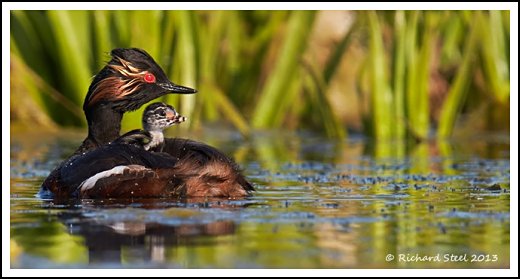 and single Reed Warblers and Reed Bunting were all still in song. and single Reed Warblers and Reed Bunting were all still in song. Tufted Ducks are late nesters and from the raised viewing platform a family party consisting of the female and seven tiny young were feeding in the nearest stretch of water just below the platform. It'll be a miracle if they all survive such has been the amount of predation this year, Lesser Black-backed Gulls and Buzzards have been the main culprits, Brian Martin the reserve recorder told us that a brood of nine Shelducks was wiped out in just a few days. One of a number of solutions to this problem being considered involves the use of [non-lethal] lasers; apparently they have been tested on the Gulls! A second brood of seven Tufted Ducks could be seen from the Morgan hide as well as all three species of Grebe with young, of course at Woolston special attention is paid to the Black-necked Grebes as the reserve is a nationally important breeding site for this species, they seem to have done well this year and Brian told us that nine pairs have produced young. On Tuesday evening (5th) Bob Groom and Jacquie Ledward had good views of the Barn Owls that are nesting in Mobberley along Pavement Lane, Bob also told me that the Hobbies have returned to their (undisclosed) nest site a few miles from Knutsford, on Wednesday evening, during a brief visit, he saw both the male and female birds, these are the only pair I'm aware of in our area at the moment but I'm sure there must be others, if so they'll become more conspicuous as the season progresses.
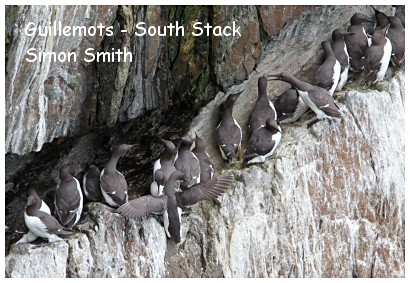 at least five hours in total - too much in one day!. We therefore decided to spread this year's visit over two days with an overnight stay at the Gwesty Carreg Bran Hotel in Llanfairpwll, located at the south end of the island, a place we'd used in previous years. at least five hours in total - too much in one day!. We therefore decided to spread this year's visit over two days with an overnight stay at the Gwesty Carreg Bran Hotel in Llanfairpwll, located at the south end of the island, a place we'd used in previous years.The journey from Knutsford to South Stack took just about two hours, passing through some very heavy rain close to the Conwy Reserve, but thereafter we were lucky with the weather and enjoyed mainly dry conditions for the rest of the trip. We had lunch at South Stack, either butties and flask or in the excellent RSPB cafe before driving the short distance to Holyhead harbour, parking on the quayside at the end of Turkey Shore Road. Here we added a few new ticks to the list, in particular the Black Guillemots that frequent the harbour, birds were seen in flight and also feeding. Summer or Winter this seems to be the place for this relatively rare species. From Holyhead we took a 30 minute drive along the coast to Cemlyn Bay, owned by the National Trust and leased by North Wales Wildlife Trust (NWWT) since 1971. Here we enjoyed some really good birding; depending on where you look for information there are up to 60 pairs of Arctic Terns, the same number of The following morning (3rd July) after an excellent breakfast at the hotel we resumed the trip with a pleasant drive along the bottom end of the island to Penmon Point, a peaceful and picturesque spot with views across to Puffin Island and, in the far distance, Llandudno and the Great Orme. The weather was great, temperature in the high teens, a few fluffy white clouds and a clear blue sky - ideal conditions to just sit and relax (we're good at that in the KOS!) Telescopes revealed clouds of auks flying around the island, too far away for specific identification but closer to us we did see Eiders and Black Guillemots passing along the coast as well as more Sandwich Terns moving north carrying food. Eventually we moved off and did a walk through the dunes, overgrown with vegetation and home to Willow Warblers, Chiffchaffs, Blackcaps, Bullfinches, lots of Linnets and a family party of Common Whitethroats. The It doesn't look far on the map but it took well over an hour to reach Gronant - it's on the A548 just past Prestatyn, next to the Presthaven caravan park, from where a path of about 600m leads to the observation platform. We added Sedge Warbler, Moorhen and Skylark to the list on the way to the platform from where we could see the terns feeding their young, most of which were hiding away from predators in the marram grass adjoining the nesting area. This year things have gone very well and the volunteers on duty told us that 172 pairs have produced 375 eggs and a total of 199 chicks have hatched; I believe 133 of these have now been ringed by David Norman. One of the wardens guided us along the beach to a safe spot where we could get a closer look at the birds, still from a distance but viewing was possible from there just using binoculars rather than the 'scopes. This has been a real success story and congratulations are due to all concerned - a great way to end our little expedition into Wales! We're fortunate at the moment in having a number of competent photographers in the KOS. Two of these Sheila Blamire and Simon Smith have sent me a selection of their images taken over the weekend for inclusion on the website. Those I didn't used have been put into an album which can be viewed by clicking here (those with no attribution are mine)
About an hour before kickoff tonight (24th) it didn't look too promising for our evening walk around the fields of Mobberley as we endured yet another downpour, something we've had to get used to over the past few weeks as the month threatens to be the wettest June on record. 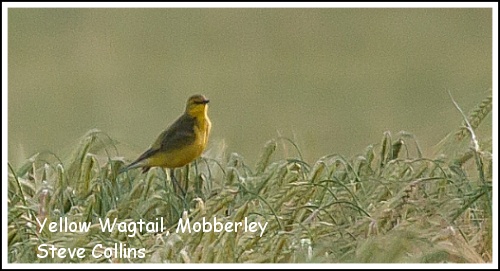 Fortunately by the time we met up on Mill Lane the rain had passed over and the walk was completed in pretty benign conditions. From Mill Lane we headed south along footpaths through fields of oats, barley, maize and potatoes (to be used for Walker's crisps - helping to keep Britain fat!) as far as Pedley Brook where we then swung west, across the stream to Springwood Farm and eventually, via Gleave House Farm, back to the cars. Fortunately by the time we met up on Mill Lane the rain had passed over and the walk was completed in pretty benign conditions. From Mill Lane we headed south along footpaths through fields of oats, barley, maize and potatoes (to be used for Walker's crisps - helping to keep Britain fat!) as far as Pedley Brook where we then swung west, across the stream to Springwood Farm and eventually, via Gleave House Farm, back to the cars. The route, of just over three miles, was a bit rough and boggy in places but everyone finished in one piece, including Sue's grandson, 7 year old Jayden, complete with his own binoculars and bags of enthusiasm; let's hope he joins us again, we could do with some young blood! There seemed to be good
We were lucky with the weather on Sunday (12th) for our KOS field trip to Leighton Moss RSPB Reserve, the weather people were predicting heavy showers but in the event we saw no rain until we were leaving for home in late afternoon. The new "sky tower" was our first port of call, it affords great views 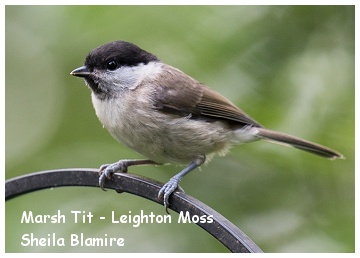 across the whole reserve and would be an ideal place to watch the Marsh Harriers and Bitterns should they put in an appearance, unfortunately both species were conspicuous by their absence! An immature Harrier was seen in the afternoon from the public hide but apparently Bitterns haven't nested now for three years and efforts are underway to persuade them to remain on the reserve and breed after wintering in the area. across the whole reserve and would be an ideal place to watch the Marsh Harriers and Bitterns should they put in an appearance, unfortunately both species were conspicuous by their absence! An immature Harrier was seen in the afternoon from the public hide but apparently Bitterns haven't nested now for three years and efforts are underway to persuade them to remain on the reserve and breed after wintering in the area.There wasn't much to see on what water remains but a nice flock of 116 summer plumaged Black-tailed Godwits flew in accompanied by a Ruff, also in magnificent breeding attire - it posed quite nicely and everyone had good views through Sheila's 'scope. Both Reed and Sedge Warblers were in song, hidden from view, amongst the towering reeds alongside the paths as we made our way down to the Tim Jackson and Grisedale hides but, probably due to the low water levels, there was little to see from the hides apart from a Little Egret that was feeding in front of the Jackson hide. Perhaps it was our recent visit to the similar habitat to be found at the Ham Wall reserve in Somerset, an area that was teeming with birds, that made this part of Leighton Moss seem to be very much the poor relation. Lunch was taken on one of the wooden tables at the rear of the visitor centre, close to the bird feeders which were attracting a number of species including a family of Marsh Tits that posed well for the photographers in the party. 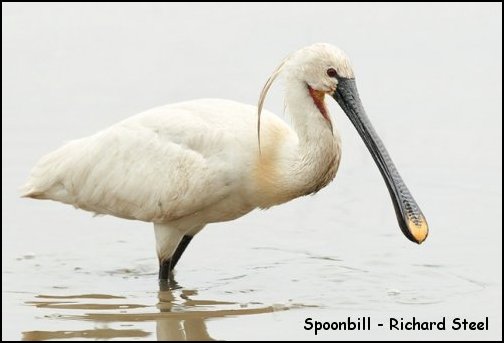 Derek couldn't be with us unfortunately, but as it was so close to his birthday and he would normally treat us to an ice cream he phoned to say that I should help to perpetuate this welcome tradition and treat the troops in the appropriate manner and he would be reimburse me in due course. So we were able to toast the Hon. Sec. with a tub of ice cream rather than something a little stronger, although I think a nice drop of red would have been cheaper than the RSPB ice cream!! Derek couldn't be with us unfortunately, but as it was so close to his birthday and he would normally treat us to an ice cream he phoned to say that I should help to perpetuate this welcome tradition and treat the troops in the appropriate manner and he would be reimburse me in due course. So we were able to toast the Hon. Sec. with a tub of ice cream rather than something a little stronger, although I think a nice drop of red would have been cheaper than the RSPB ice cream!!The route to the public hide has been improved by the construction of a very impressive wooden walkway through the reed bed, this eliminates the need to walk along the busy road before turning right onto the causeway. As well as the previously mentioned Marsh Harrier, from the public hide we recorded Kingfisher and Water Rail; good numbers of Swifts and a handful of hirundines fed overhead and as we made our way back to the cars a lone Willow Warbler was heard in full song close to the new walkway. Our final destination were the hides overlooking Morecambe Bay; a Peregrine falcon passed over as we made our way over the fields - probably one of the Warton Crag birds. No Avocets have nested this year due to problems with a sluice gate but there were a few about to add to the day list. We were also able to add species such as Redshank, Curlew, Skylark and Shelduck plus four Spoonbills that performed well in front of the Eric Morecambe hide, our final tick of the day was a Cetti's Warbler, singing loudly just to one side of us bringing the list to 62 species - quite respectable.
Ken and Shirley Davies seem to be enjoying their Scandinavian adventure and continue to head slowly north along the east coast of Sweden. By last Sunday (5th)they'd reached the town of Soraker and report seeing Velvet Scoters (4pairs), Black Woodpecker, Three-toed Woodpecker and both Red-throated and Black-throated Divers during the day. Meanwhile back here in the UK KOS members have been out and about, making the most of the current spell of good weather. Susan Middleton, Jacquie Ledward and Bob Groom enjoyed a very productive visit to the RSPB Burton Mere Wetlands Reserve on Saturday (4th) and Bob kindly sent me an email summerising their day's birding. Jacquie, Sue and I visited Burton Mere today and had wonderful views of no less than seven Spoonbills, also a female Marsh Harrier was almost constantly in view, despite being mobbed by all and sundry. We heard and saw Cetti's Warbler and had great views of several Sedge and Reed Warblers. Redshanks and Snipe were displaying repeatedly. Geoff and Sheila Blamire followed in their footsteps on Tuesday (7th.), they found that, unfortunately, the flycatcher's nest had been destroyed by a squirrel but saw most of the other species mentioned by Bob. Talking to Colin Wells, the reserve warden, Sheila found that the staff have put up an anti-predator fence around the area containing the pools nearest the information centre and more than 130 pairs of waders are breeding; Lapwings, Avocets, Redshank and Snipe plus Shovelers (rare in Cheshire). They are planning to put up a similar fence around the original IMF pool next year, as well as a big new hide overlooking this area; this will be accessible to all visitors to the Reserve. Derek Pike reports that eight Lapwings were on the big field at the north end of Lilac Avenue, two of these appeared to be incubating eggs. We met here on Wednesday morning on our way to Woolston Eyes, it was great to hear a Skylark in full song over the field, just a short walk from Knutsford town centre! Don't forget this Sunday 12th June we have our KOS field trip to Leighton Moss, leaving the Tatton Street car park at 08:30am
Barrie Armitt's adventures in Canada are now at an end and he should now be on his way home with 200+ species under his belt; I'm hoping that he'll do a trip report for this website in due course. On Monday (30th May) both Bob Groom and Geoff and Sheila Blamire paid separate visits to the area around Haydyn's Pool in Northwich and came up with similar lists. The pair of Garganey are still showing from time to time on the pool near the larger island whilst on the smaller island the Oystercatchers have enjoyed some success, Geoff and Sheila saw at least one youngster in company with one of the adults that appeared to be still incubating the remaining eggs. Blackcaps, Chiffchaffs, Common Whitethroats plus Reed, Sedge and Garden Warblers were all in song and Geoff and Sheila heard the Cetti's Warbler from the vegetation near Carden's bridge. On Wednesday (1st June) we found ourselves once again heading for the hills, this time to the village of Bonsall, hidden away in the Pennines, just a short distance from the town of Matlock and, before the arrival of ex-KOS members Alison Lea and Mark Eddowes, famous only as the venue for the annual World Championship Hen Racing competition at the Barley Mow pub in the centre of the village! 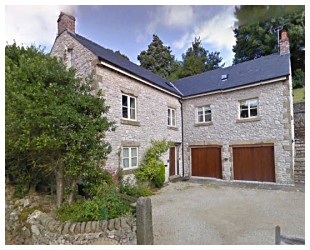 Alison and Mark's house lies just up the road from the pub; a beautiful new building constructed using traditional materials at the bottom of a steep slope with a large terraced garden that will keep them busy for a long time! Alison kindly provided refreshments before we set off along a route prepared by Mark that took us Alison and Mark's house lies just up the road from the pub; a beautiful new building constructed using traditional materials at the bottom of a steep slope with a large terraced garden that will keep them busy for a long time! Alison kindly provided refreshments before we set off along a route prepared by Mark that took us 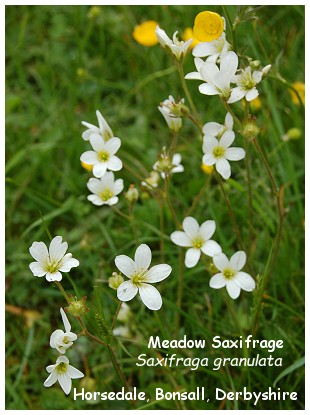 through an area known as Horsedale, out of the village, up a wooded valley that eventually opened out into steep-sided meadows containing Buttercups, the increasingly rare Meadow Saxifrage and lots of other flowers that needed the expertise of John Somerville to help with their identification! Blue Tits, Great Tits and House Sparrows were busy feeding young, Mark had counted 7 Blue Tit eggs in one nest box and five chicks successfully fledged. The weather was overcast and it was quite cool and windy as the path climbed higher. Plenty of Swallows and House Martins were seen but surprisingly no Swifts, they do seem to be in short supply this year. Common Whitethroats, Willow Warblers, Chiffchaffs, Blackcaps and Garden Warblers were all still singing and eventually the rattle of a Lesser Whitethroat was heard in the distance. We walked for about an hour before eventually returning along the same route, pausing to watch a fine male Redstart which gave good views as we passed through it's territory in an old stone building close to the path. through an area known as Horsedale, out of the village, up a wooded valley that eventually opened out into steep-sided meadows containing Buttercups, the increasingly rare Meadow Saxifrage and lots of other flowers that needed the expertise of John Somerville to help with their identification! Blue Tits, Great Tits and House Sparrows were busy feeding young, Mark had counted 7 Blue Tit eggs in one nest box and five chicks successfully fledged. The weather was overcast and it was quite cool and windy as the path climbed higher. Plenty of Swallows and House Martins were seen but surprisingly no Swifts, they do seem to be in short supply this year. Common Whitethroats, Willow Warblers, Chiffchaffs, Blackcaps and Garden Warblers were all still singing and eventually the rattle of a Lesser Whitethroat was heard in the distance. We walked for about an hour before eventually returning along the same route, pausing to watch a fine male Redstart which gave good views as we passed through it's territory in an old stone building close to the path.We ended our visit at the splendid little Fountain Tea Rooms in the centre of the village before driving back into Cheshire after a very enjoyable mornings birdwatching. Many thanks Alison and Mark - with your permission we'll pay a return visit to this very civilised part of the world in the near future.
Friday evening (27th) found us on the first of our KOS evening walks, on this occasion up into the Pennines, starting in the Goyt Valley before moving on to another location later. We'd visited the valley a couple of weeks previously (12th) on a mid-week walk but that was in the morning, this time it wasn't until 7:30pm that we set off (no less than 22 members - most encouraging!). Predictably things were much quieter this time but it was a very pleasant evening with blue skies and no rain or wind, Curlews could be heard in the distance and much closer to us at least two Cuckoos were calling; a couple of times we had views of them flying - a pity we were in Derbyshire and not just over the border, I've still not seen or heard one in Cheshire this year. Willow Warblers, Chiffchaffs, Song Thrushes and Wrens were all singing despite the late hour but Tree Pipits, Redstarts and Pied Flycatchers weren't heard although later in the walk some of the party watched a pair of Redstarts busily feeding young in a roadside Oak tree. Along the river Grey Wagtails were again present and on the shore of the Errwood reservoir a pair of Little Ringed Plovers were seen, there wasn't much activity but there's a chance they could be nesting there, it's an ideal location. 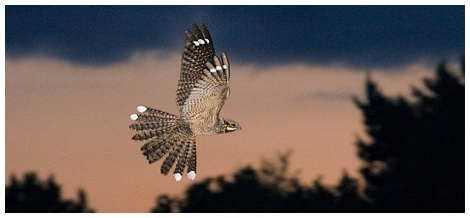 Time was marching on and the light was fading so, on our return to the cars, we drove out of the valley to another location hoping, optimistically, that we would hook up again with the Nightjars we'd seen 12 months ago. Our optimism paid off and after some time waiting silently in the appropriate spot (yes silently - not a word normally associated with the KOS!) a very soft "churring" was audible in the distance. Slowly it became louder and eventually one or perhaps two individuals were seen; better views than last year, at one time a bird perched in a dead tree further up the slope from where we were stood, silhouetted against the last light of the day, and staying long enough for the 'scopes to be focussed on it. As our old friend Gordon Yates would have said - "it just doesn't get any better"! Time was marching on and the light was fading so, on our return to the cars, we drove out of the valley to another location hoping, optimistically, that we would hook up again with the Nightjars we'd seen 12 months ago. Our optimism paid off and after some time waiting silently in the appropriate spot (yes silently - not a word normally associated with the KOS!) a very soft "churring" was audible in the distance. Slowly it became louder and eventually one or perhaps two individuals were seen; better views than last year, at one time a bird perched in a dead tree further up the slope from where we were stood, silhouetted against the last light of the day, and staying long enough for the 'scopes to be focussed on it. As our old friend Gordon Yates would have said - "it just doesn't get any better"!No recent news from Barrie, now in the high Arctic of Canada but Ken and Shirley Davies have probably now reached a similar latitude in Norway where their trip list now exceeds 100. Closer to home Derek and Jean has excellent views of up to five individual green Woodpeckers on a route taking them along Beech Walk in Tatton Park, their local stronghold.
The KOS trip to Somerset went very well I've put the report on a separate page,to read it please click here! On Sunday (22nd) our Tatton correspondent, Alan Booth had a Spotted Flycatcher and a Male Redstart at the far end of Tatton Mere Covert. Interesting records, I've not heard of any Spotted Flycatchers in the park for some time and the last Redstart record was in the 1980's when a pair nested at the Outdoor Centre, close to where the Sunday bird was seen! Barrie Armitt's trip to the colonies continues and I can think of no better way to relay the news of his latest adventures than by reproducing his emails below!
16/05/2016 Seen 32 of the 36 adding Wilson's, Worm-eating and Mourning this morning. Connecticut is a late migrant and the last of them all to go through....no sign or reports of yesterday's bird. On day 14 of 30 so should add a couple more warblers....trip list is 168 and 2 places to visit on way back to camp...getting tougher to add new birds. Yesterday was hail and snow fell. ..Added Prairie Warbler and Pileated Woodpecker at Rondeau Park...few birds singing and didn't blame them. Sun today ? The Wilson's was penultimate North American warbler I had targeted and particularly satisfying as the one on Uist last autumn was co-found by non other than Roy Dennis ..purveyor of fine wellingtons to the gullible. Coffee break done. Enjoy Somerset 23/05/2016 Day 20 and it's hot. Warnings- always uttered with a knowing grin- about the swarms of flies awaiting me in Algonquin, have sent me out shopping for a 'bug' hat ...checked out the full suit version but not available in a continental cut...sartorial elegance wins out over loss of blood? Added Marbled Godwit to trip list this morning: trip now stands at 193. Remarkable how few warblers remain; they really do pass through in large numbers in a short time frame- 10 day period and then it's a trickle or nothing. However much remains and some birds are looking fantastic. Had 1300 Grey Plover yesterday that got up with 70 Bonaparte's Gulls and headed north...The former for the arctic tundra, the latter for the trees they nest in further north....gulls in trees: bizarre. Still trying to add wood warbler 33 of 36 to the list... have heard Connecticut Warbler singing 3 times but still no views. The Louisiana Water thrush was given a (p)(provisional) after I saw, heard and photographed a bird - wasn't sure and asked a few of the local birders to offer an opinion...con census was Northern. Hope the KOS trip went well and look forward to reading about it in due course. 14/05/2016...... Lovely morning in the Goyt Valley.Summer seems to have arrived all of a sudden, the maximum temperature reached on both the 29th and 30th April was a chilly 8 °C but by last Sunday (8th) we were sweltering at 25.1 °C. The warmer weather may have encouraged the return of our Reed and Sedge warblers to Knutsford Moor at last, 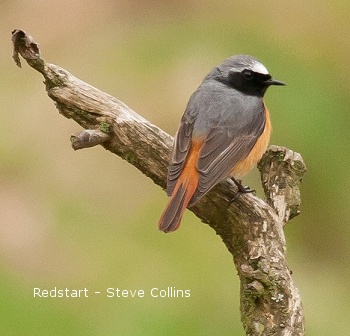 Alan Booth had his first of the year last Wednesday (4th) with 3 Reed and 2 Sedge in song. Also on the 4th. Stan Allen re-visited a Raven's nest he and his wife had discovered three weeks previously in Tatton Park, it seems to have been successful and contained three well-grown young. Alan Booth had his first of the year last Wednesday (4th) with 3 Reed and 2 Sedge in song. Also on the 4th. Stan Allen re-visited a Raven's nest he and his wife had discovered three weeks previously in Tatton Park, it seems to have been successful and contained three well-grown young.On Wednesday (11th) we paid our first visit of the season to the Goyt Valley, despite a less than encouraging weather forecast, apart from some light precipitation on the road up to Pym Chair, we enjoyed a dry day, although there was little in the way of song until mid-morning when the sun finally appeared.
Bob Groom has been on his travels again with another visit to Bulgaria, Bob appears to have found it rather disappointing due to bad weather, nevertheless he did manage over 100 species and if you click here you can read his report. News from abroad - Ken and Shirley Davies are in Denmark at the start of their Scandinavian adventure whilst even further away in Canada Barrie (The Lad) Armitt now has 27 out of his target of 35 North American Warblers during his trip to Point Pelee, the southern-most mainland location in Canada - There was much excitement on Saturday (30th. April) over at Woolston Eyes when the ringers caught a real rarity in their mist nets. It was a White-crowned Sparrow (Zonotrichia leucophrys) , a 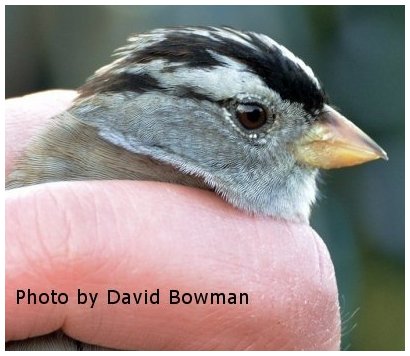 North American species, common over there but previously recorded only six times in the British Isles! After processing the bird was released close to the Morgan hide where it was seen on and off for a few hours before moving on. Nevertheless, despite entry to the reserve normally being open to permit holders only, it was decided to give everyone a chance to see it should it return and a small charge was made for access to the reserve the following day; I believe
£
300 was taken, unfortunately the bird failed to re-appear. North American species, common over there but previously recorded only six times in the British Isles! After processing the bird was released close to the Morgan hide where it was seen on and off for a few hours before moving on. Nevertheless, despite entry to the reserve normally being open to permit holders only, it was decided to give everyone a chance to see it should it return and a small charge was made for access to the reserve the following day; I believe
£
300 was taken, unfortunately the bird failed to re-appear.We travelled over to Woolston this morning (4th) and enjoyed some great weather at long last with the mercury peaking at 17 ° C. in mid-afternoon. Surprisingly we didn't see or hear a single Willow Warbler although Chiffchaffs and Blackcaps were present in good numbers and the first Common Whitethroats were very active, enjoying the perfect weather. We spent some time waiting for a Garden Warbler to show itself; just to confirm it's identity as it's apparently quite uncommon on the reserve, eventually it showed very well, in full song at the top of a small oak tree. In the meantime Sheila and Frank had made their way to the raised viewing platform and were delighted to see an Osprey hovering over the far end of the reserve, it remained in view for only a short time before drifting off in a westerly direction. Before reaching the main hide (The Morgan) we heard our first Grasshopper Warbler of the season reeling in the distance, it wasn't very distinct but later on, our way out of the reserve, it was somewhat louder, although it remained unseen in deep cover. We enjoyed our elevenses in the Morgan hide, remembering to spare a thought for Barrie Armitt, who's now jetted off to Canada and had informed us that at that particular moment he would be enjoying his first morning's birding at Point Pelee! Reed and Sedge Warblers were singing close 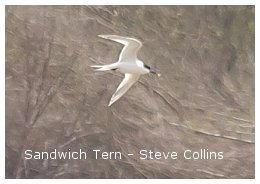 to the hide, on the water Black-necked, Great Crested and Little Grebes were all present and a trickle of hirundines passed through plus one or two Common Swifts high over the reserve. 52 species in all, not a bad total, the final entry was a Cetti's Warbler heard briefly in song close to the footbridge. to the hide, on the water Black-necked, Great Crested and Little Grebes were all present and a trickle of hirundines passed through plus one or two Common Swifts high over the reserve. 52 species in all, not a bad total, the final entry was a Cetti's Warbler heard briefly in song close to the footbridge.Temperatures over the previous weekend had remained well below average with highs only in single figures. Migrating hirundines in considerable numbers spent their time wasting precious energy fluttering low over the local meres in search of newly emerging insects; at Rostherne Bob Groom counted 400 House Martins on the 1st of the month, whilst the following day at Marbury he had c 1000 hirundines, this time mostly Swallows. He also saw a single Black Tern over the mere whilst over at Tatton I had two Common Terns and Steve Collins reports that the long-staying Sandwich Tern can still be seen at the Acre Nook sand quarry in Chelford; an unusual inland record.
Roy Bircumshaw died a dew days ago after struggling with ill health for a considerable time. Whilst not a founder member of the society he'd been around for many years and 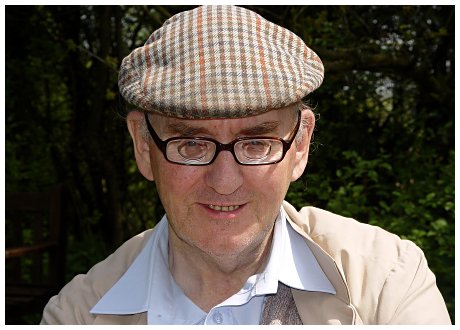 gladly volunteered to become Secretary of the KOS when Peter Perkins, who was first to hold the post, moved out of the area. He'd led an interesting life and possessed a huge vocabulary which he put to good use when thanking speakers to the Society's Friday evening meetings in his own unique, ebullient manner! We're fortunate at the moment having so many members who are prepared to spend much time and energy running the Society, especially the extended field trips, but this wasn't always the case and Roy often had to struggle on his own. We extend our sympathies to Roy's son Carl and his family, they've lost a father and grandfather and we've lost a good friend. gladly volunteered to become Secretary of the KOS when Peter Perkins, who was first to hold the post, moved out of the area. He'd led an interesting life and possessed a huge vocabulary which he put to good use when thanking speakers to the Society's Friday evening meetings in his own unique, ebullient manner! We're fortunate at the moment having so many members who are prepared to spend much time and energy running the Society, especially the extended field trips, but this wasn't always the case and Roy often had to struggle on his own. We extend our sympathies to Roy's son Carl and his family, they've lost a father and grandfather and we've lost a good friend. Roy's funeral will take place on Thursday 5th May at St. Cross Church at 1pm, followed by cremation at Altrincham Crematorium. The present period of cold weather is dragging on far too long for the well-being of our wildlife; I managed a walk around the lanes of Mobberley this morning before the conditions deteriorated during the afternoon,
25/04/2016...... Three new arrivals After a week of very pleasant Spring weather with temperatures in the mid to upper teens things have taken a downturn over the weekend and a large anticyclone in mid-Atlantic has come into play 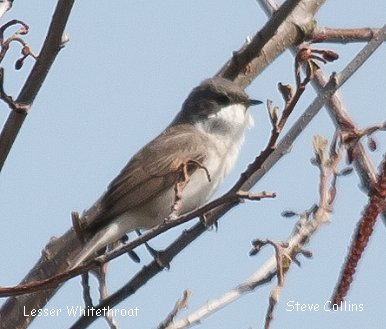 bringing us what could be a long period of cold conditions straight down from the arctic.
bringing us what could be a long period of cold conditions straight down from the arctic.In Tatton Park yesterday morning (24th) it felt more like the end of February than the last week of April with a maximum temperature of only 7 ° C. this, and heavy showers, combining to give early migrants a challenge they could do without; let's hope it doesn't last too long. New KOS member Steve Collins was out and about on Friday (22nd) exploring the area of Mobberley to the east of Springwood Farm and recorded Linnets, Yellowhammer and a singing Lesser Whitethroat at the fishing pit where the path meets the track that runs from Gleavehouse Farm to the Dun Cow pub, close to Ollerton crossroads. This seems to be an attractive location to the species - we've had them there for the past few Summers. The Society's AGM on Friday went very smoothly, lasting only 12 minutes this year, not a record but not too onerous giving plenty of time for Sheila (and Geoff) Blamire to entertain us with their latest presentation "three months birding in Europe" - including mid-Winter trips to the continent in search of Vultures, Eagles and Wolves which could involve up to 12 hours in an un-heated hide with only a tin bucket for company!! The main points to arise from the AGM were that the committee was seen to be a little top heavy and it was decided to reduce the number of members by two. Our excess of income over expenditure was
£
310, a much improved picture following three consecutive years of losses, most satisfactory! On Wednesday (20th) KOS member Ken Davies heard a Cuckoo whilst playing golf at Delamere Golf Club, it was his first of the year having gone all 2015 without hearing one in Cheshire; this was the case for most of us Ken! At the same time as Ken had the Cuckoo we were enjoying the beautiful weather in Northwich, we did a 5K circuit in an anti-clockwise direction around Ashton's / Neumann's flashes, over to Haydn's pool before returning to the cars via Carden bridge. 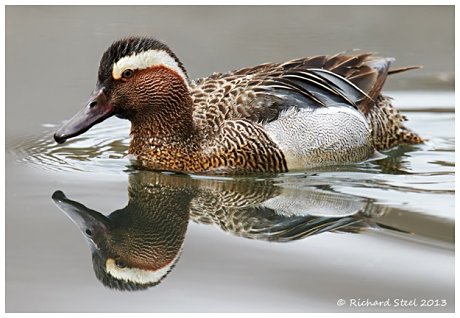 Amongst the first bird we heard on setting off from the Witton Mill bridge car park was our first Sedge Warbler of the year, it was a very active individual flying from the top of one willow to another, pausing on each for a few seconds allowing good views through the 'scopes. A short distance further on a second new one in the form of a Common Whitethroat, well hidden but an unmistakable song of course. It's an excellent year for warblers and as we headed towards the first hide someone remarked that we were walking through a tunnel of song - with Chiffchaffs, Willow Warblers, Whitethroats, Robins, Goldfinches, Dunnocks, Blackbirds and Song Thrushes all playing their part in providing us with a very pleasant experience. The water level on Neumann's is currently very high, a pair of Great Crested Grebes were displaying but the only island is completely submerged, it was here that we noted a single Swallow - the only hirundine of the morning. A pair of Garganey seem to be finding Haydn's pool to their liking, they've been there for more than a week now and have been seen copulating on a number of occasions. They showed well for us on the smaller of the two islands although there wasn't much action and they spent their time side by side dozing in the warm morning sun! On the bigger island an Oystercatcher was incubating eggs, a Green Woodpecker was seen under the Kestrel box on the opposite side of the pool and new species number three, a Reed Warbler, was singing to the left hand side of the viewing screen. Don't forget tomorrow night (Friday 22nd) it's our AGM. It never lasts more than 15 minutes and no one will be press ganged into joining the committee, all the current members are willing to serve another year, of course if you feel you'd like to help out in any capacity speak up, new blood is always welcome! After this short event our Hon. Chairman Sheila will be entertaining us with a presentation entitled "Three Months Birding in Europe" - sounds good Sheila!
More Summer migrants are arriving by the day, on Tuesday (12th) Darren Morris had two Common Terns in Tatton Park over the main mere, perhaps they're the same two that spent some time with us last Summer when they were watched fishing on Knutsford Moor before flying off to the east carrying their catch, which made us think they were perhaps nesting locally. Also on the 12th two Common and one Arctic Tern were seen at Woolston Eyes, as well as a Ring Ouzel near the No4 bed sandpit pond and the first Common Sandpiper of the year. There was no sign of any of these birds yesterday when we visited the reserve, nevertheless there were plenty of others about on what seemed to be the first really spring-like day of the year with blue skies and a maximum temperature of 15 ° C recorded during the afternoon. From the footbridge leading to the hides we noticed a pair of Shelducks below us on the banking where they're probably going to nest in one of the many rabbit holes at that location. A little further on our first Blackcap of the season was singing from the undergrowth, followed a short time later by a Willow Warbler; the first of 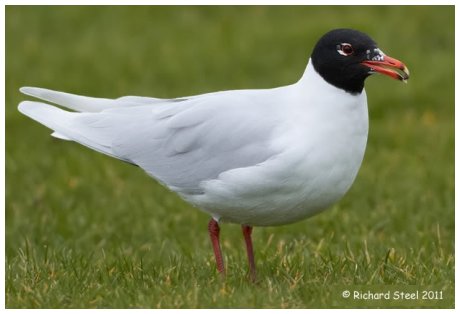 many we heard during the morning, it seems it as though it will be a good year for them and also Chiffchaffs - over 100 of the latter were recently counted on the reserve! As we stood on the raised viewing platform a Cetti's Warbler exploded into song just a few yards to one side of us, there are a few at Woolston but that's the first time we've actually heard one our regular mid-week visits. many we heard during the morning, it seems it as though it will be a good year for them and also Chiffchaffs - over 100 of the latter were recently counted on the reserve! As we stood on the raised viewing platform a Cetti's Warbler exploded into song just a few yards to one side of us, there are a few at Woolston but that's the first time we've actually heard one our regular mid-week visits.There are currently seven Black-necked Grebes on the reserve, some were on view from the Morgan hide, but there was no evidence of nesting activity - it's perhaps just a bit too early. Also showing well were a pair of Mediterranean Gulls that looked like a pair rather than individual birds, they remained in close contact with each other throughout the time we were there. A female Marsh Harrier floated over the reedbeds at one stage causing a bit of a panic amongst the other birds, including the flock of 20+ Brambings that are still frequenting the feeders along side the main hide. This morning (14th) the little lady and I were driving towards Middlewich from the direction of Byley, just before we got to the bridge that crosses the Dane on the outskirts of Middlewich I noticed a large bird hovering over the river. Initially I assumed it was a Buzzard but as we got closer I could see it had well defined black and white markings rather than the usual wishy-washy appearance of most Common Buzzards. Luckily, just before the bridge, there's a lay-by used by the local fishermen and so I swung into there at speed managing to stop just before a large oak tree at the end and quickly exited the vehicle ignoring the torrent of abuse, not normally heard outside the Stretford End, from the passenger seat. I didn't have my binocs in the car but we were close enough to confirm my suspicions that it was an Osprey! It flew to one of those very tall electricity pylons where it remained for a few seconds before being mobbed by the local corvids and headed off north, in the general direction of Northwich and Knutsford.
Knutsford apparently enjoyed some very pleasant weather on Saturday (9th) with hazy sunshine and just the odd shower in the late afternoon. We were 70 miles away to the west enjoying the April KOS field trip to north Wales, walking the Great Orme above Llandudno during the morning and visiting the RSPB reserve at Conwy in the afternoon - the weather in Wales proved to be a little more changeable. Following a pleasant ascent in the cars up the marine drive we parked in the usual place, first left after the "Rest-and-be-Thankful" cafe and up to the parking area at the top. 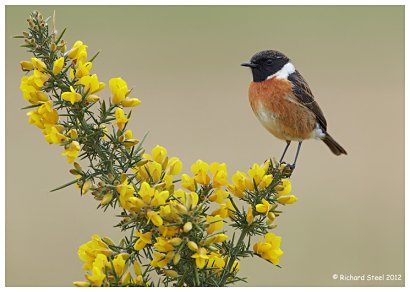 The weather wasn't too bad to begin with, although ominous clouds were approaching over Conwy Bay, and we had excellent views of Stonechats, Wheatears and displaying Meadow Pipits as we made our way carefully over the Orme's famous limestone pavement. Thereafter though things stated to go downhill as the weather we'd seen over the bay reached us on the Orme; rain at first quickly changing to sleet, then to snow and finally hailstones before reverting to light rain driven into our faces on a strong westerly wind. These conditions continued as we descended the zig-zag path down to the marine drive and again as we struggled up to the lighthouse, past the cafe and back up to the cars (looking on Google Earth the ascent from where we joined the marine drive to the car park was 364feet - isn't that the height of St. Paul's Cathedral?). So we were cold and wet, some wetter than others, my coat was soaked right through and I can confirm that Nikwax just doesn't work - at least not on my coat! Viewing was all but impossible as everyone's optics misted up although we did manage to add Guillemot and Fulmar to the day list, hopefully last Saturday was an exception and hasn't put too many members off the idea of the Great Orme walk permanently, it's a magical location. The weather wasn't too bad to begin with, although ominous clouds were approaching over Conwy Bay, and we had excellent views of Stonechats, Wheatears and displaying Meadow Pipits as we made our way carefully over the Orme's famous limestone pavement. Thereafter though things stated to go downhill as the weather we'd seen over the bay reached us on the Orme; rain at first quickly changing to sleet, then to snow and finally hailstones before reverting to light rain driven into our faces on a strong westerly wind. These conditions continued as we descended the zig-zag path down to the marine drive and again as we struggled up to the lighthouse, past the cafe and back up to the cars (looking on Google Earth the ascent from where we joined the marine drive to the car park was 364feet - isn't that the height of St. Paul's Cathedral?). So we were cold and wet, some wetter than others, my coat was soaked right through and I can confirm that Nikwax just doesn't work - at least not on my coat! Viewing was all but impossible as everyone's optics misted up although we did manage to add Guillemot and Fulmar to the day list, hopefully last Saturday was an exception and hasn't put too many members off the idea of the Great Orme walk permanently, it's a magical location.Things were better down at the Conwy reserve and after a warm drink in the cafe we set off with renewed vigour around the perimeter paths. It was high tide, and it was a big one, there were plenty of waders roosting on the pools, mainly Black-tailed Godwits, Redshanks and Curlews; the Curlews looked to be in superb condition and gave great views through the 'scopes. Hirundines were passing through in large groups and the heavy rain earlier may have forced migrating warblers to seek shelter as the bushes were full of Chiffchaffs and Willow Warblers, a White Wagtail showed well on the short turf on one of the islands close to the second hide and near the information centre, underneath one of the feeders, a flock of House Sparrows - remember them?!
Chiffchaffs seem to be everywhere at the moment, yesterday on my daily walk around Mobberley I counted 10 singing males plus one in our back garden, Derek heard one on Knutsford Heath and on Sunday (3rd) there were five between Knutsford Moor and the bathing area in Tatton. 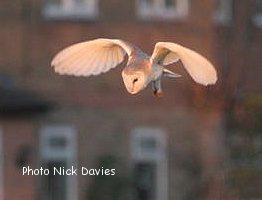 Also in the park, on the main mere, another Black-necked Grebe was present and I was pleased to see a Kingfisher flying up from the direction of the moor, they will be nesting now so it's worth taking a careful look at the banking, both on the mere and also Melchett, where they've nested in the past. I counted about 20 Goldeneye from the bathing area plus around 50 Sand Martins and a handful of Swallows a figure dwarfed by the 600+ seen yesterday (5th) over Budworth Mere by Bob and Jacquie! They also had a Peregrine and a singing Blackcap, I believe there are quite a few there already as well as the first Willow Warblers of the year. Also in the park, on the main mere, another Black-necked Grebe was present and I was pleased to see a Kingfisher flying up from the direction of the moor, they will be nesting now so it's worth taking a careful look at the banking, both on the mere and also Melchett, where they've nested in the past. I counted about 20 Goldeneye from the bathing area plus around 50 Sand Martins and a handful of Swallows a figure dwarfed by the 600+ seen yesterday (5th) over Budworth Mere by Bob and Jacquie! They also had a Peregrine and a singing Blackcap, I believe there are quite a few there already as well as the first Willow Warblers of the year.Back in Mobberley I was out down Pavement Lane on Monday evening looking for Wheatears in the horse paddocks (one along Mereheath Lane last Thursday (31st March)), I had no luck with them but, as I was talking to two bird watchers from Plumley, a Barn Owl appeared, quartering the field to the south of Pavement Lane before moving over to the field next to Pavement Lane Farm where we'd watched a pair last year. It stayed in view for some time and at one point flew within a few yards from where I'd stationed myself, just north of the farm next to the new gate. Unfortunately last night (5th) it failed to put in appearance at a similar time but the resident pair of Little Owls showed well with lots of calling plus copulation - a sight I'd never seen previously! The picture below was kindly sent to me by Gwyndaf Roberts, a friend from the Knutsford Photographic Society, it was taken at Neumann's Flash on the 16th March and shows the pre-roost gathering or "murmuration" of Starlings that quite a few of our members were lucky enough to witness at the time. Gwyn seems to have arrived at a good estimate of the number present - "by scrutiny of the images and using a grid method to calculate numbers I came up with 320,000" - thanks Gwyn that's probably more accurate than our usual method of counting the legs and dividing by two - yes I know some of you have heard that one before, but not everyone has!
Cool but dry conditions on Wednesday (30th) for a gentle stroll around Tatton Park. We actually covered 7.5K or about 4½ miles, beginning as usual on Knutsford Moor, then alongside the main mere before walking past the old hall to a 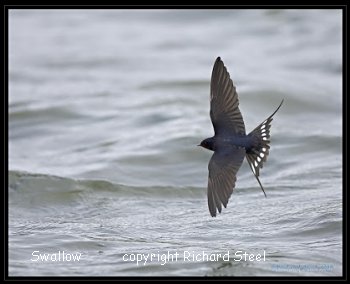 position overlooking the Deer Park, followed by elevenses in the Allen hide and finally back to Dog Lodge via Dog Wood. position overlooking the Deer Park, followed by elevenses in the Allen hide and finally back to Dog Lodge via Dog Wood.The single Chiffchaff on the moor from last week had been joined by others and we heard four singing birds before entering the park at the main gate. On the moor pool a pair of Great Crested Grebes were displaying and showing every intention of constructing a nest on the east side of the water; they should be ok there as it's very boggy and probably safe from human interference. The heronry in the Higmere plantation still has two occupied nests, if all is well they should now be well into incubation, although they appear to have begun nesting a little later than usual this year. Further up the main mere we came upon the hirundines, mostly Sand Martins with around 50 present, although it was difficult to count them as we were experiencing visible migration with birds arriving from the south and others towering up before leaving to the north. Our sharp-eyed Chairman picked out the first House Martin of the season in amongst the Sand Martins and most of us managed to get on to it without too much trouble. We chose to walk up beyond the old hall because it's been there, on the open grassland, that Wheatears have been seen in previous years and this is the optimum time of the year for seeing them on their way north; but not this Wednesday unfortunately! We ate our sausage rolls in the comfort of the Allen hide and as usual put the world to rights (no one ever seems to listen to us though!), the feeders had been emptied before the start of the breeding season so there was little in the way of avian activity but we were delighted to see the first Swallow of the year flying low over Melchett mere, it remained with us for a few minutes before heading north. A Mistle Thrush was putting on a virtuoso performance in the small wood behind the hide as we left to make our way back, one of four heard in song - we had only one Song Thrush during the whole morning.
The large high pressure system that has dominated our weather for the past two weeks has weakened during the last 24 hours allowing an area of low pressure to move in from the west, bringing with it southerly gale force winds. So it should now become a little warmer and encourage more migrants to move north from the Iberian peninsula where they've probably been waiting for more favourable conditions. Our mid-week walk took us around the Northwich Woodlands 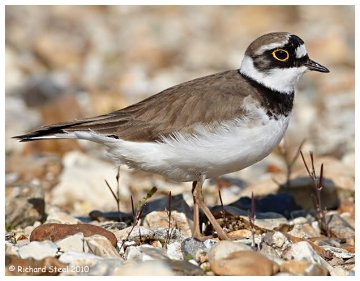 (Haydn's Pool, Neumann's Flash, Budworth Mere etc.) and we managed to accrue a reasonable total of 58 different species, but only two of those were spring migrants. A single Sand Martin was flying over Budworth Mere and, out on the sand spit across the mere from where we were viewing, Hugh Pulsford picked out a Little Ringed Plover - demonstrating the advantage that a decent telescope brings, but at
£
2799 for the latest Leica I think I'll be quite content to ensure I go birding with companions who have deeper pockets than me!! (Haydn's Pool, Neumann's Flash, Budworth Mere etc.) and we managed to accrue a reasonable total of 58 different species, but only two of those were spring migrants. A single Sand Martin was flying over Budworth Mere and, out on the sand spit across the mere from where we were viewing, Hugh Pulsford picked out a Little Ringed Plover - demonstrating the advantage that a decent telescope brings, but at
£
2799 for the latest Leica I think I'll be quite content to ensure I go birding with companions who have deeper pockets than me!!A trip into Tatton, taking in Knutsford Moor, Dog Wood and up to the bathing area on Thursday (24th) produced just two Sand Martins but the following day (25th) as well as three Sand Martins a Chiffchaff was in song on the Moor and I was delighted to come across two Black-necked Grebes, showing nicely in the middle of the main mere. No doubt they are en route to Woolston but with a bit of luck they may hang about for a few days - they have in the past. Yesterday's Birdguides sightings included 11 instances of this species so they seem to be on the move. Further afield the first Osprey has returned to the Dyfi reserve, although not one of last year's successful pair. It's well worth a look at the webcam (click here)- full HD and HiFi sound but perhaps best to avoid the associated chat room with it's bunny huggers and teleclappers! [NB] 20/03/2016...... The search for first Sand MartinThe main hide at Woolston Eyes (the Morgan hide) is as good as you'll find anywhere, being purpose built on the edge of number 3 bed, giving great views looking east over what is the main area of 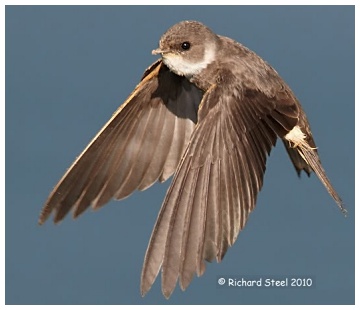 interest for visiting bird watchers. It's only drawback, as we found on Wednesday (16th) when we went in search of the year's first Sand Martin, is the very fact that it faces east and consequently when there's an easterly wind blowing in through the open windows it makes for uncomfortable viewing, especially when you're looking for a tiny bird only 5" long weighing in at 14g ( about half of one ounce)!! interest for visiting bird watchers. It's only drawback, as we found on Wednesday (16th) when we went in search of the year's first Sand Martin, is the very fact that it faces east and consequently when there's an easterly wind blowing in through the open windows it makes for uncomfortable viewing, especially when you're looking for a tiny bird only 5" long weighing in at 14g ( about half of one ounce)!! We did our best but it was to no avail, although birds had been already been recorded in the midlands they didn't yet seem to have ventured up as far as Cheshire. The well-stocked feeders outside the hide were attracting some birds, but fewer than on our last visit; the Greenfinches seem to have dispersed but there were still a few Chaffinches and some well-marked Bramblings on view. The first Black-necked Grebe returned to the reserve this week but there was no sign of that either. A few miles to the east in Tatton Park, ranger Darren Morris was determined to uphold the park's reputation for early migrants and was able to spend a few minutes during the day scanning the main mere for hirundines. Unlike last year though, when he was rewarded on the 16th, this time he was unlucky and inevitably two days later (18th) when he was away on a course the first Sand Martin appeared, low over the mere at 2:30 in the afternoon! I make that Rangers 0 - KOS 1 Darren! Next on the Tatton list is Chiffchaff and I'm sure that in the next few days they'll be singing in Dog Wood and joined, not long after, by Blackcaps. Conditions are ideal at the moment for early migration with a large high pressure system sitting firmly over the British Isles, so yesterday (13th), on our KOS March field trip to RSPB Burton Mere we were cautiously optimistic that the first Sand Martin of the year would put in a much anticipated .jpg) appearance. appearance.Unfortunately it wasn't to be but there are already some in the country and I'm sure we'll have our first before the end of this week. By way of compensation though we did have two Chiffchaffs, the first - seen only by the Inner Marsh Hide and the second, in full song, in-between the reception building and the marsh covert hide. Was this a "true" migrant or one of the increasing number of birds that now over-winter with us? There's been a build-up of Avocets on the reserve and up to 25 have been counted, we recorded 16, so it's looking encouraging for the coming breeding season. Incidentally if you'd like to learn more about Avocets in northern England then CLICK HERE this chap puts an amazing amount of effort into monitoring the population at Leighton Moss. There was plenty of activity on the pools in front of the reception building where, as well as the Avocets, we had Kingfisher, Stonechat and a Spotted Redshank that was the subject of some discussion until it flew a few yards and we able to able to positively ID it. As we were making our way towards the inner marsh hide we were delighted to hear the song of a Cetti's Warbler from the reeds just in front of the first viewing screen and, on this occasion, we were able to watch it from a distance of only a few yards as it made it's way through the phragmites before flying off low across the water to a new location. A second bird was heard near the marsh covert hide, with a third in amongst a tangle of vegetation where the boardwalk ended. Colin Wells, the Reserve warden, told me that they had up to five males singing last year, with one pair probably attempting to nest.
A reasonable count of 47 species yesterday (10th) on a mid-week trip across to Parkgate for the big spring tide (10.2m). Unfortunately conditions were quite benign with no wind  to push the water up as far as the sea wall and as a consequence the birds weren't forced into the air and seemed content to sit out the tide in relative safety. to push the water up as far as the sea wall and as a consequence the birds weren't forced into the air and seemed content to sit out the tide in relative safety. We based ourselves at the Parkgate Old Baths and from there spent some time walking along the sea wall with the estuary on one side and the golf course on the other. From here we had our first raptors of the day with distant views of Marsh and Hen Harriers, a few Skylarks were in full song over the marsh and in the paddock behind the car park a small flock of Redwings in beautiful plumage were showing well in the slightly overcast but bright conditions. A Peregrine falcon spent some time overhead as we walked up as far as the chippie, whilst on the way back we enjoyed watching a "ringtail" Hen Harrier before getting really good views of the first Short-eared Owl of the day as it slowly quartered the marsh close to the roadside
Baz
When does the spring begin? For many people it's around the time of the spring equinox (20th March) when the days become longer than the nights, but for the Met. Office and for statistical convenience it's today - March 1st...............The meteorological seasons consists of splitting the seasons into four periods made up of three months each. These seasons are split to coincide with our Gregorian calendar making it easier for meteorological observing and forecasting to compare seasonal and monthly statistics. By the meteorological calendar, spring starts on 1 March.......... Of course neither are correct because as we all know Spring begins in these parts when the first Sand Martin is seen over Tatton Mere, normally around the 14th of this month! 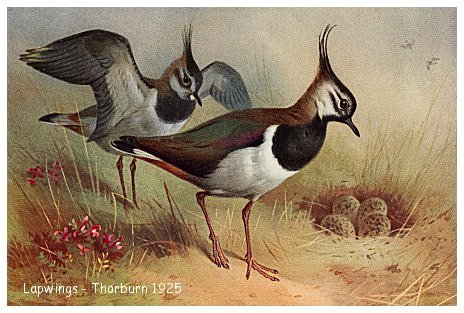 So we have a couple of weeks to go yet but our resident species can't hang about for that long and I was delighted to see (and hear) four Lapwings displaying over the big field opposite Smith Lane Farm in Mobberley yesterday morning - one of nature's most evocative sounds, whilst a couple of hundred yards further on a Skylark was in full song, just a dot in a clear blue sky. So we have a couple of weeks to go yet but our resident species can't hang about for that long and I was delighted to see (and hear) four Lapwings displaying over the big field opposite Smith Lane Farm in Mobberley yesterday morning - one of nature's most evocative sounds, whilst a couple of hundred yards further on a Skylark was in full song, just a dot in a clear blue sky.Let's hope these birds and any that arrive later are successful; they have every chance as the fields, lying either side of the Manchester to Chester railway line, are farmed in accordance with one of the governments agricultural environment schemes (AESs) in which farmers sign up to receive payments for environmentally beneficial actions that are outside their normal farming practices. As well as potential nesting species the area has been attracting some winter visitors; Len Mason had 25 Linnets recently and I've seen a flock of Yellowhammers there - yes a flock! Well just 6 birds actually, but it's a good sign as the species is only just hanging on locally as a breeding species. Birds with a long journey ahead of them before too long are still with us - the usual increase in Siskins is underway and they can be seen in good numbers, often in quite substantial groups feeding in waterside Alders and flocks of Redwings and Fieldfares seem to vary in size from day to day as they start to move north in anticipation of the warmer weather. Bob Groom had a Red Kite over Green Lane in Knutsford, perhaps the bird seen recently in Tatton, Derek Pike reports that there are now two Pintails on Melchett Mere in Tatton park and two Bitterns have been seen recently; one in the Coward reedbed at Budworth Mere with a second seen by Phil Dell at Rostherne. 22/02/2016...... KOS Tatton Field Trip Stan Allen from Altrincham, a regular visitor to the park for the past 40 years, reports that he saw his first ever Red Kite in Tatton on the 14th February. There certainly haven't been many records recently, although some years ago a juvenile bird that had been ringed as a nestling in Wales spent part of the winter there, albeit mostly over the deer park, not an area generally accessible to the public. It can't be long before they decide that Cheshire's to their liking - after all they've now become a common sight in many other parts of the country. Our KOS February field trip to Tatton took place last Sunday (21st), I had to miss it unfortunately but Frank Dearden has once more provided an account of proceedings 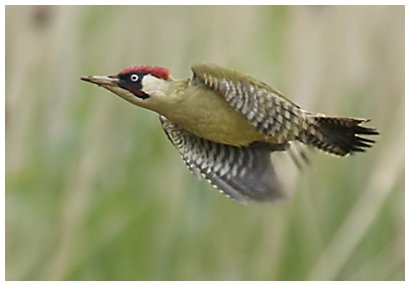 ........... A party of eleven members and one dog set off in mild, overcast
conditions for a circuit of Tatton Park.
Prior to assembling for the walk in Dog Lodge lay-by, Derek Pike
started the day well with a flock of c.50 Lapwings over fields to the
north of Northwich Road.
Our route took us along the east side of a very soggy Knutsford Moor
and through Dog Lodge Wood to Tatton Mere. The wildfowl selection on
the Mere included both male and female Goldeneye whilst above the trees
to the east we had the welcome site of a hovering Kestrel.
The Allen Hide, overlooking Melchett Mere, provided a welcome mid-walk
break and here we caught up with Bob Groom who was having a less
energetic foray into the Park. He reported a Green Woodpecker on his
way in, a bird we were to catch up with later ourselves when Phil Rowley
spotted one flying across Beech Walk.
A probable group of thrushes seen on open ground to the north of the
Allen Hide caused us to set off for a closer look. A large flock was
revealed with Redwings and Starlings dominating along with a smaller
representation of Fieldfares.
Our return walk took us around Melchett and down the western side of
Tatton Mere to the Knutsford entrance of the Park where a flyby from a
Sparrowhawk brought our outing to an appropriate conclusion.
Species seen - 37 ........... A party of eleven members and one dog set off in mild, overcast
conditions for a circuit of Tatton Park.
Prior to assembling for the walk in Dog Lodge lay-by, Derek Pike
started the day well with a flock of c.50 Lapwings over fields to the
north of Northwich Road.
Our route took us along the east side of a very soggy Knutsford Moor
and through Dog Lodge Wood to Tatton Mere. The wildfowl selection on
the Mere included both male and female Goldeneye whilst above the trees
to the east we had the welcome site of a hovering Kestrel.
The Allen Hide, overlooking Melchett Mere, provided a welcome mid-walk
break and here we caught up with Bob Groom who was having a less
energetic foray into the Park. He reported a Green Woodpecker on his
way in, a bird we were to catch up with later ourselves when Phil Rowley
spotted one flying across Beech Walk.
A probable group of thrushes seen on open ground to the north of the
Allen Hide caused us to set off for a closer look. A large flock was
revealed with Redwings and Starlings dominating along with a smaller
representation of Fieldfares.
Our return walk took us around Melchett and down the western side of
Tatton Mere to the Knutsford entrance of the Park where a flyby from a
Sparrowhawk brought our outing to an appropriate conclusion.
Species seen - 37
The idea was simple enough; on Wednesday (10th) we'd spend the morning at the RSPB Burton Wetlands Centre and, as the 10 meter high tide pushed up the Dee estuary, 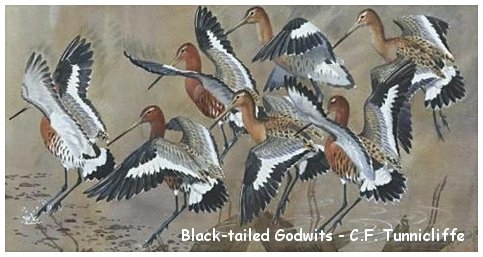 the displaced birds would seek refuge on the reserve giving us some really good views as they waited for the waters of the Dee to recede as the tide ebbed. Did it and did they? Well no, not exactly, the tide certainly came in but unfortunately the birds hadn't read the script and failed to put in an appearance. In fact the pools in front of the Inner Marsh hide remained very sparsely populated - it was a bit like the Etihad on a bad day! the displaced birds would seek refuge on the reserve giving us some really good views as they waited for the waters of the Dee to recede as the tide ebbed. Did it and did they? Well no, not exactly, the tide certainly came in but unfortunately the birds hadn't read the script and failed to put in an appearance. In fact the pools in front of the Inner Marsh hide remained very sparsely populated - it was a bit like the Etihad on a bad day!Still we didn't do too badly and ended up with a respectable total of 43 species for the morning. There was plenty going on in front of the reception building with good numbers of wildfowl, 12 Grey Herons and just a single Little Egret plus a flock of 100 plus Black-tailed Godwits that were very active, at one stage the whole flock were feeding on the grassland next to the perimeter path which must have been very soft after weeks of winter rain. A small flock of Siskins showed well in the alders overhanging the path and a group of 15 Linnets gave good views through the 'scopes whilst perched in an oak tree close to the railway bridge leading to Burton Point. We walked up to the point from the Inner Marsh hide, but again there was little to see and it was perishing so we made our way back to the sanctuary of the reception building where I felt obliged to treat everyone to a warm drink as it was my birthday!
Unfortunately I was unable to travel to Northwich today due to being struck down by man 'flu, nevertheless a small but robust group assembled and, braving the weather, headed off in the direction of Haydn's Pool - here's how they got on ...... It was a very depleted team that assembled at Witton Mill Bridge car park - Dave Butterworth, Bill Killey, Derek and Myself. A small group but well balanced; two good talkers and a couple of good listeners. 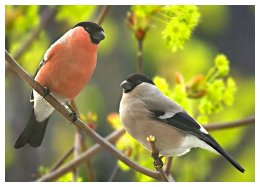 Probably the best sighting of the day was recorded just a few paces
from the car park when three Bullfinches(1m 2f) alighted on a bush
alongside the path. They showed well for two minutes before flying
across the open land to the west.
We took the usual route towards Haydn's Pool, stopping just below it to
monitor the reedbed. There, Derek identified two clear bursts of song
from a Cetti's Warbler. Conditions were very poor at this point, some
15-20 minutes of heavy rain, and no sightings were achieved. At Haydn's
Pool itself the water level was very high and two Coot was the only
birdlife evident on it.
Under a clearing sky we departed from our usual route to make a full
circuit of Neumann's Flash. The water level here was again very high
and the variety of birdlife much reduced from normal; the best sighting
from the first (western) hide being a mixed flock of 40 Shoveler and
Teal.
From the eastern hide the dominating sight was a flock of Black-headed
Gulls resting on the water. A total of 370 were counted with a dozen
showing well in breeding plumage at this early point in the year.
The total of different species seen in the morning was a lowly 22. ....... Frank Dearden
Probably the best sighting of the day was recorded just a few paces
from the car park when three Bullfinches(1m 2f) alighted on a bush
alongside the path. They showed well for two minutes before flying
across the open land to the west.
We took the usual route towards Haydn's Pool, stopping just below it to
monitor the reedbed. There, Derek identified two clear bursts of song
from a Cetti's Warbler. Conditions were very poor at this point, some
15-20 minutes of heavy rain, and no sightings were achieved. At Haydn's
Pool itself the water level was very high and two Coot was the only
birdlife evident on it.
Under a clearing sky we departed from our usual route to make a full
circuit of Neumann's Flash. The water level here was again very high
and the variety of birdlife much reduced from normal; the best sighting
from the first (western) hide being a mixed flock of 40 Shoveler and
Teal.
From the eastern hide the dominating sight was a flock of Black-headed
Gulls resting on the water. A total of 370 were counted with a dozen
showing well in breeding plumage at this early point in the year.
The total of different species seen in the morning was a lowly 22. ....... Frank Dearden
Thanks Frank just as our old English teacher liked it - clear and concise! 31/1/2016...... Big Garden Birdwatch on Knutsford Moor and a trip to Woolston
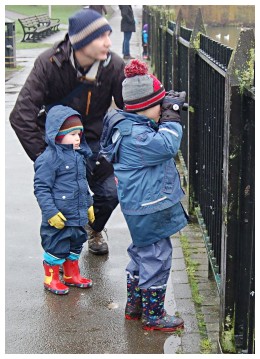 We've enjoyed better weather in the past for our annual get together with our chums from "The Friends of Knutsford Moor" as they participated in the RSPB's "Big Garden Birdwatch", it was only about 6°C with a steady drizzle for most of the time, nevertheless there was a good turnout and we came across some nice birds including Kingfisher and Treecreeper, these haven't been recorded before, in a grand total of 35 species - 7 more than last year. We've enjoyed better weather in the past for our annual get together with our chums from "The Friends of Knutsford Moor" as they participated in the RSPB's "Big Garden Birdwatch", it was only about 6°C with a steady drizzle for most of the time, nevertheless there was a good turnout and we came across some nice birds including Kingfisher and Treecreeper, these haven't been recorded before, in a grand total of 35 species - 7 more than last year.Fieldfares and Redwings were absent from this year's list but the Moor pool was proving to be attractive to more species than we've seen previously, including Pochard and Shoveler.
From the raised viewing platform we could see that a wide "ride" had been cut through the reedbed - I've found this link to reedbed management (you have to click it Frank!) - so therein, no doubt, an explanation for this action can be found! Perhaps the secondment, from the RSPB, of a young man to help with management of the reserve for a 12 month period has something to do with it. The machine used to cut the reeds is called a Truxor, a video of it in action on the reserve has been posted on YouTube. Go on admit it you'd love a go on that!
It was suggested by some visitors that we should provide hot drinks as an added incentive, they were only joking of course, but perhaps it not such a bad idea for next year - an orange box set up outside the hide with one of those small gas stoves heating a kettle of hot water, a couple of cartons of milk, some coffee granules and tea bags and away you go - all donations gratefully received! As it was, this time we could only offer a drop of Scotch kindly provided by Roger Barnes, in rather a nice hip flask, who insisted he didn't want it back until it had been emptied, we did our best Roger (as did some of the punters) but there's still a bit left over which I'll dispose of in an appropriate manner! Eight KOS members turned out to help on the day so, to avoid overcrowding in the hide when things became busy, some chose to head off around the park to do a bit of birding and were able to add a few more species such as Green Woodpecker, little Grebe, Raven and Goldeneye to the mornings list which finally crept up to 37 species, not very impressive of course, but the morning was about more than that.
Our first trip of the year, to the Northwich Woodlands Reserve (Neumann's / Budworth etc.), went very well indeed although it got off to a less than auspicious start as when we arrived we found the barrier to the car park still locked! This prompted a rapid change in plans and much confusion as plans B and C had to be aborted for various reasons leaving members scattered to the four wind all over Northwich!! 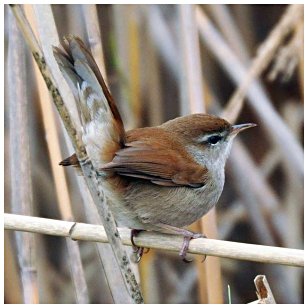 Fortunately the problems were resolved when a young lady appeared with the keys and, a few phone calls later, by the time we got as far as Butterfinch Bridge the party was back together again (17 members + 3 pooches). It was when we were stood on the bridge that an explosion of sound from deep in the reedbed announced the presence of a Cetti's Warbler causing the Hon. Sec. to spin through 90° whilst simultaneously leaping two feet into the air like a coiled spring - and why not because for most of us this was the first time we'd heard one in Cheshire!! We moved from the bridge a short distance along the path below Haydyn's Pool where the bird put on a virtuoso performance for us ; let's hope he finds a mate later in the Spring. This was always going to be the highlight of the day, perhaps even of the year, but there was a day list to be populated so, after ticking off a skulking Water Rail, we set off in the direction of Budworth Mere via Haydn's Pool. Elevenses were taken in the shelter near to the Ranger's cabins taking advantage of the splendid little butty bar that opens there every weekend serving freshly made food and drinks including barm cakes from Goostrey's in Mobberley and bacon from Waugh Brow Farm - also in Mobberley! Fortunately the problems were resolved when a young lady appeared with the keys and, a few phone calls later, by the time we got as far as Butterfinch Bridge the party was back together again (17 members + 3 pooches). It was when we were stood on the bridge that an explosion of sound from deep in the reedbed announced the presence of a Cetti's Warbler causing the Hon. Sec. to spin through 90° whilst simultaneously leaping two feet into the air like a coiled spring - and why not because for most of us this was the first time we'd heard one in Cheshire!! We moved from the bridge a short distance along the path below Haydyn's Pool where the bird put on a virtuoso performance for us ; let's hope he finds a mate later in the Spring. This was always going to be the highlight of the day, perhaps even of the year, but there was a day list to be populated so, after ticking off a skulking Water Rail, we set off in the direction of Budworth Mere via Haydn's Pool. Elevenses were taken in the shelter near to the Ranger's cabins taking advantage of the splendid little butty bar that opens there every weekend serving freshly made food and drinks including barm cakes from Goostrey's in Mobberley and bacon from Waugh Brow Farm - also in Mobberley!Moving on to the viewing screen the feeding station was attracting the usual mixed crowd of Tits and Nuthatches whilst a Kingfisher was seen a number of times during the time we were there, 23 Curlews were counted over the far side of the mere but very few Grey Herons seem to have returned to what used to be the biggest heronry in England. Bob had decided not to walk as far as the mere and spent the time at Neumann's flash where he was able to add Siskin, Long-tailed Tit, Raven, Green Woodpecker, and a pair of displaying Peregrine Falcons to the list, which finally totalled 55 species, very respectable for this time of the year.
Weather permitting this coming Sunday (17th) we'll be teaming up again with the Tatton rangers for a Winter Birdwatch. It takes place between 11am and 1pm in and around the Allen Hide overlooking Melchett Mere, so if you're at a loose end on the day, come along and join in the fun, KOS members normally outnumber any visitors we manage to attract!! 03/1/2016...... Sad NewsA sad start to the new year with news, from her daughter Susan, that Elizabeth Perkins has died, she was 90 years of age. She and her late husband Peter were 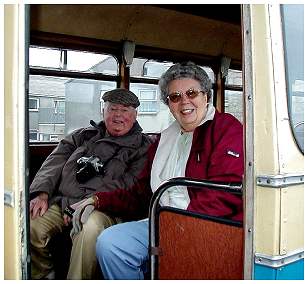 founder members of the Society back in 1974, in fact they helped organise the WAE classes in the two years before then that eventually lead to the formation of the KOS.
Peter was our Secretary for many years before Roy Bircumshaw took the reins and he and Elizabeth moved to Nantwich to be nearer to their two daughters. Apparently Elizabeth had just returned from holiday to her flat when she suffered a stroke and passed away later that day (31st December). Her funeral will be held on Monday 18th January at St Mary's Church Nantwich at 11.00am. founder members of the Society back in 1974, in fact they helped organise the WAE classes in the two years before then that eventually lead to the formation of the KOS.
Peter was our Secretary for many years before Roy Bircumshaw took the reins and he and Elizabeth moved to Nantwich to be nearer to their two daughters. Apparently Elizabeth had just returned from holiday to her flat when she suffered a stroke and passed away later that day (31st December). Her funeral will be held on Monday 18th January at St Mary's Church Nantwich at 11.00am. In his Nature Notes column in the Times Derwent May states that "Song Thrushes are singing everywhere", well he obviously doesn't live in Mobberley, I've not heard one yet despite being out and about most mornings, if there any still left in the area I would expect to hear them soon. No sign either of Mistle Thrushes, although Bob Groom had a singing bird in Tatton Park where Alan Booth reports that a pair of Stonechats can still be seen in the Melchett Mere area. Our January field trip to the Neumann's/Budworth area of the Northwich Woodlands reserve takes place this coming Saturday (9th), meeting at the Sessions House at 9:00am or 9:15 at the usual Witton Bridge car park. Perhaps we'll be able to locate the Cetti's Warbler (a new bird for the reserve) that's been recently discovered. A little further away ex KOS member Malcolm Greenhaulgh now living on Majorca sent me a nice list of species he saw on New Years day. Snipe, Common Sandpiper, Marsh Harrier, Peregrine Falcon, Serin, Cetti's Warbler, Balearic Warbler, Fan-tailed Warbler,Moustached Warbler, Blackcap, Chiffchaff, Crag Martin, Black Redstart, Common Redstart, Stonechat, Whinchat, Little Egret, Cattle Egret, No hangover. - I believe all but the last one Monty! | ||||||||||||||||||||||||||||||||||||||||||||||||||||

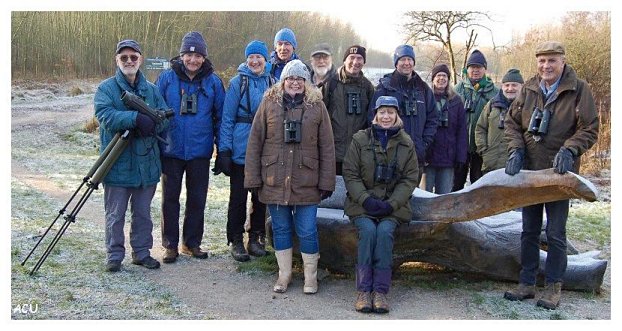
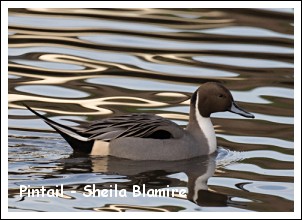 it wasn't particularly cold but a steady breeze from the Irish sea made it a morning to make for the various hides rather than stand out in the open for long periods.
it wasn't particularly cold but a steady breeze from the Irish sea made it a morning to make for the various hides rather than stand out in the open for long periods.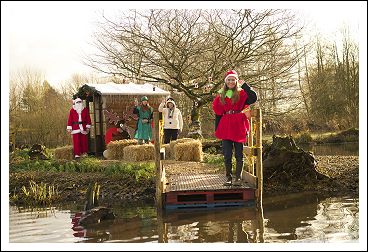 area.
area.
 Locally KOS members Steve Collins and Phil Dell had two Whooper Swans at Rostherne on the 26th and also the Lesser Spotted Woodpecker on the same day with another sighting by Phil in front of the observatory on the 27th.
Locally KOS members Steve Collins and Phil Dell had two Whooper Swans at Rostherne on the 26th and also the Lesser Spotted Woodpecker on the same day with another sighting by Phil in front of the observatory on the 27th.
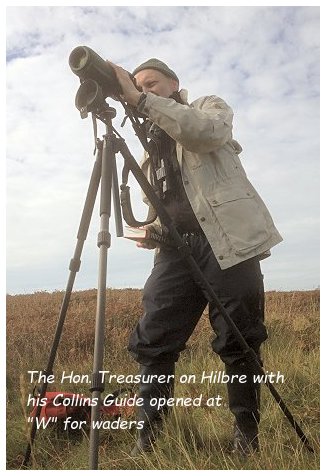 during the four or five hours to be spent on the island. A steady stream of Swallows passed through during the day but only one Skua was recorded and we saw just two Sandwich Terns when normally there would have been plenty around, together with their Arctic, Little and Common cousins.
during the four or five hours to be spent on the island. A steady stream of Swallows passed through during the day but only one Skua was recorded and we saw just two Sandwich Terns when normally there would have been plenty around, together with their Arctic, Little and Common cousins. 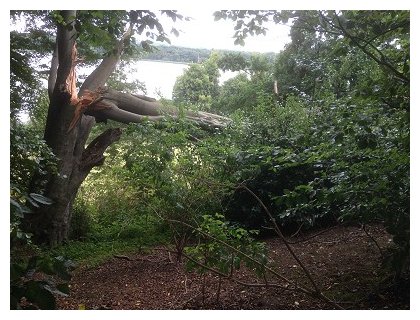 the reserve, the Observatory has been cut off from the rest of the world by a huge branch that has detached itself from the main trunk and fallen over the approach path completely blocking it and crushing the railings running alongside. I hadn't heard anything about this when I travelled over to Rostherne last Tuesday (30th) so I had no idea when it had happened and did a quick check to ensure no one had been using the path as it came crashing down! I was joined by a chap from Natural England (the warden was on holiday and this was his boss) he said his men could tackle most things but this, at first glance, was too big a job for them. I've not heard anything since so I don't know when the obs. will re-open.
the reserve, the Observatory has been cut off from the rest of the world by a huge branch that has detached itself from the main trunk and fallen over the approach path completely blocking it and crushing the railings running alongside. I hadn't heard anything about this when I travelled over to Rostherne last Tuesday (30th) so I had no idea when it had happened and did a quick check to ensure no one had been using the path as it came crashing down! I was joined by a chap from Natural England (the warden was on holiday and this was his boss) he said his men could tackle most things but this, at first glance, was too big a job for them. I've not heard anything since so I don't know when the obs. will re-open. 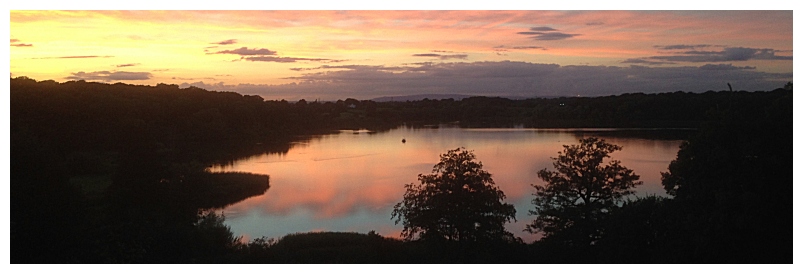


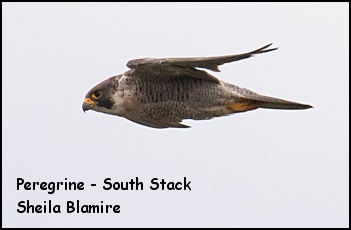 Choughs have bred successfully again and they were enjoying the blustery conditions that continued all morning; Rock Pipits too were unaffected by the wind and were seen rising from the shelter of the cliffs in display flight two or three times but diving for cover when one of the resident Peregrine Falcons powered overhead - great views.
Choughs have bred successfully again and they were enjoying the blustery conditions that continued all morning; Rock Pipits too were unaffected by the wind and were seen rising from the shelter of the cliffs in display flight two or three times but diving for cover when one of the resident Peregrine Falcons powered overhead - great views.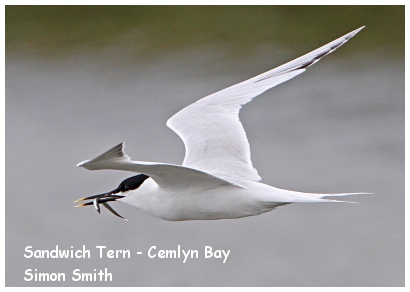 Common Terns and up to 2,500 pairs of Sandwich Terns nesting on the reserve! Making it the third biggest colony of Sandwich Terns in the UK.
Common Terns and up to 2,500 pairs of Sandwich Terns nesting on the reserve! Making it the third biggest colony of Sandwich Terns in the UK.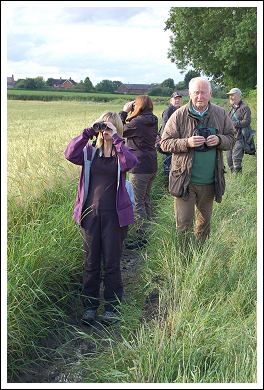 numbers of Swallows feeding over the first of the big fields, this year housing acres of barley, and Geoff Blamire (minus 'scope on this occasion) picked out a superb male Yellow Wagtail perched on top of the ripening crop. (see picture taken tonight). There were two birds, both collecting insects, sometimes eating them and at other times dropping out of sight; perhaps feeding fledged young?
numbers of Swallows feeding over the first of the big fields, this year housing acres of barley, and Geoff Blamire (minus 'scope on this occasion) picked out a superb male Yellow Wagtail perched on top of the ripening crop. (see picture taken tonight). There were two birds, both collecting insects, sometimes eating them and at other times dropping out of sight; perhaps feeding fledged young?
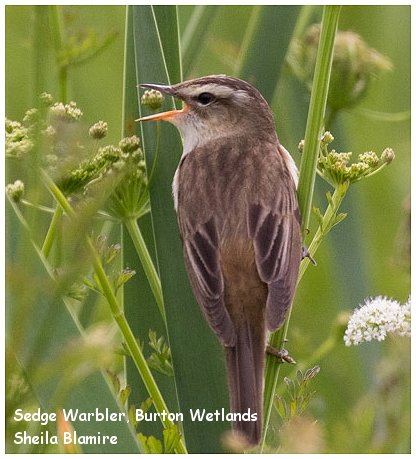 At one point I counted well over 200 Black-Tailed Godwits from the Marsh Covert Hide and there were at least another 50 or 60 near the observatory and IMF hide. Spotted Flycatchers were visible from the car park. There were an incredible 70+ Avocet chicks (let's hope most survive) plus many adults Despite not seeing some 'obvious' species ( like Sparrowhawk, Kingfisher and Great Spotted Woodpecker) we managed a respectable total of 60 species between us. A very good day indeed.......... BOB
At one point I counted well over 200 Black-Tailed Godwits from the Marsh Covert Hide and there were at least another 50 or 60 near the observatory and IMF hide. Spotted Flycatchers were visible from the car park. There were an incredible 70+ Avocet chicks (let's hope most survive) plus many adults Despite not seeing some 'obvious' species ( like Sparrowhawk, Kingfisher and Great Spotted Woodpecker) we managed a respectable total of 60 species between us. A very good day indeed.......... BOB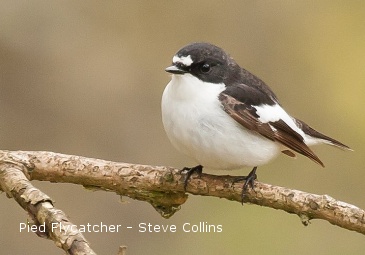 We parked up in the normal Errwood car park and set off up the steep slope at the rear before joining the path that runs along the side of the hill parallel with the road below.
We parked up in the normal Errwood car park and set off up the steep slope at the rear before joining the path that runs along the side of the hill parallel with the road below. 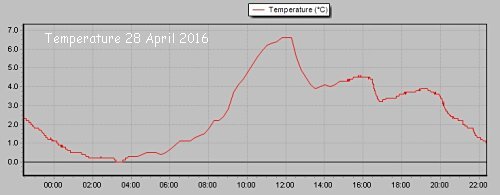
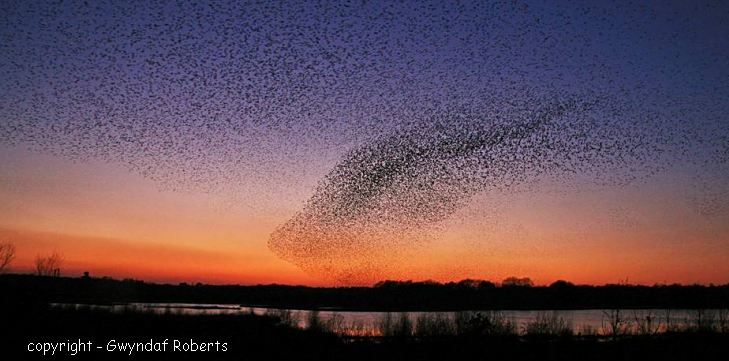
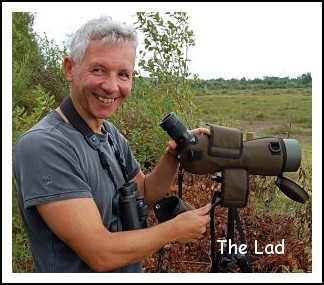 Our Middle East correspondent Barrie (the lad) Armitt is off on his travels again and in response to my email about yesterday's proposed trip to the Wirral sent the following reply .............
Our Middle East correspondent Barrie (the lad) Armitt is off on his travels again and in response to my email about yesterday's proposed trip to the Wirral sent the following reply .............